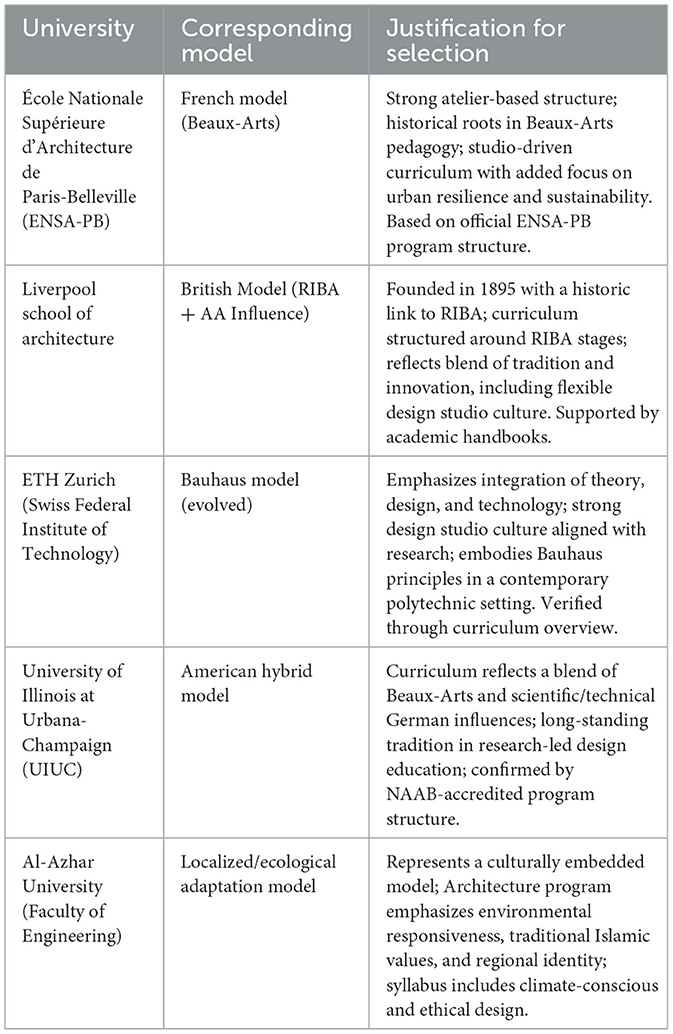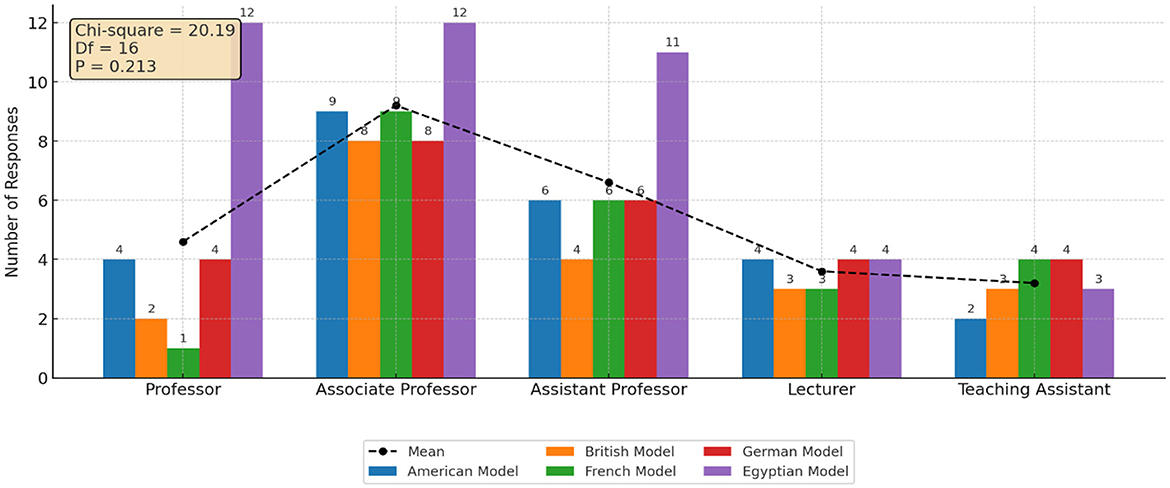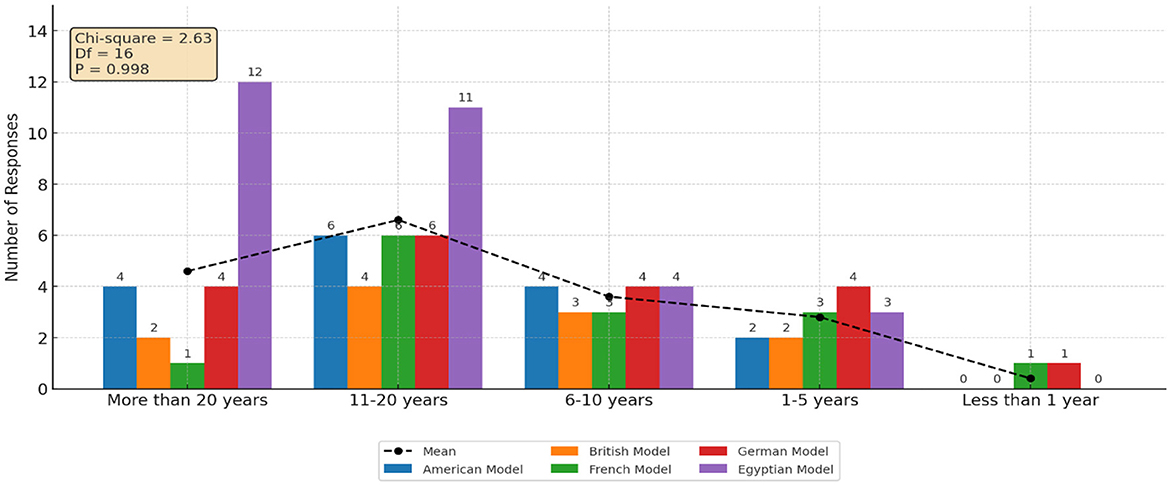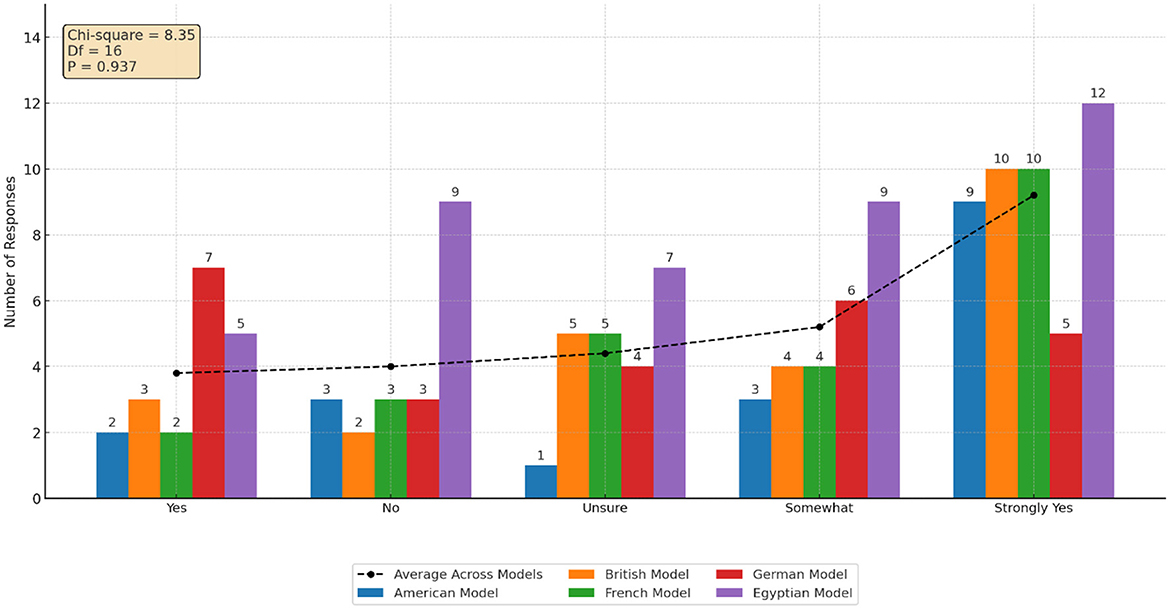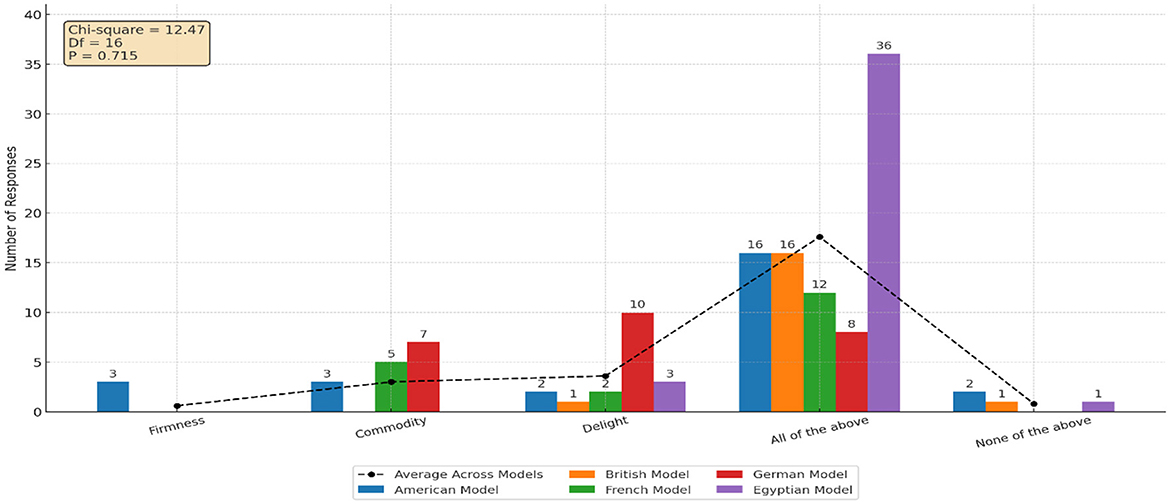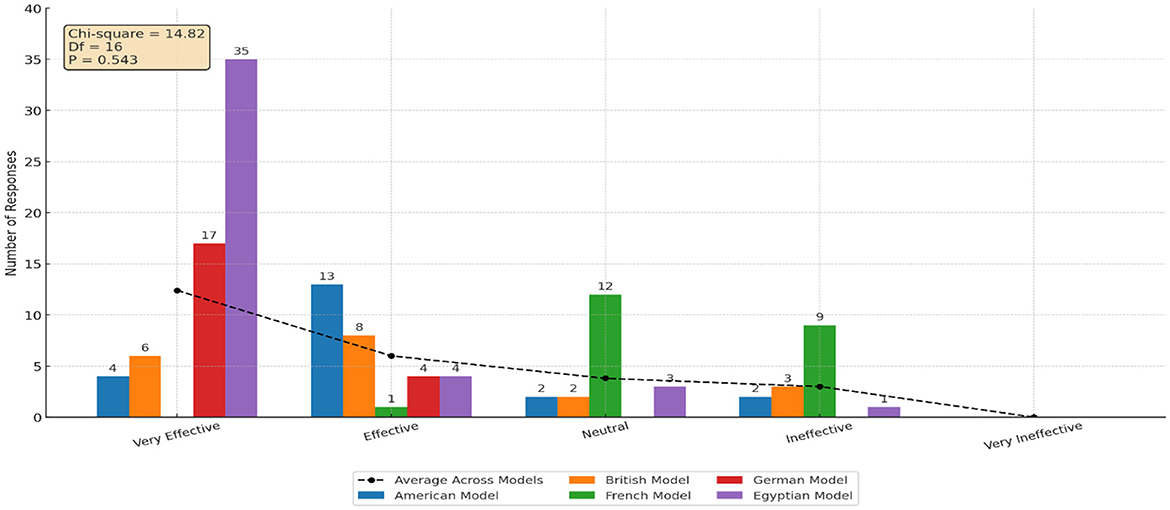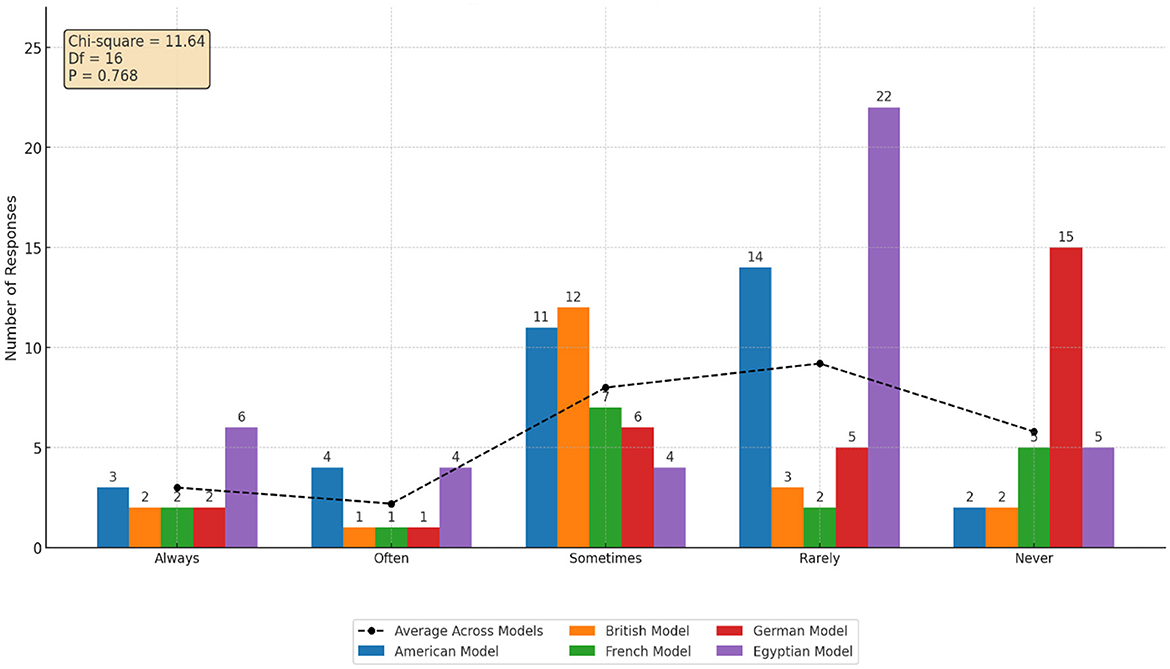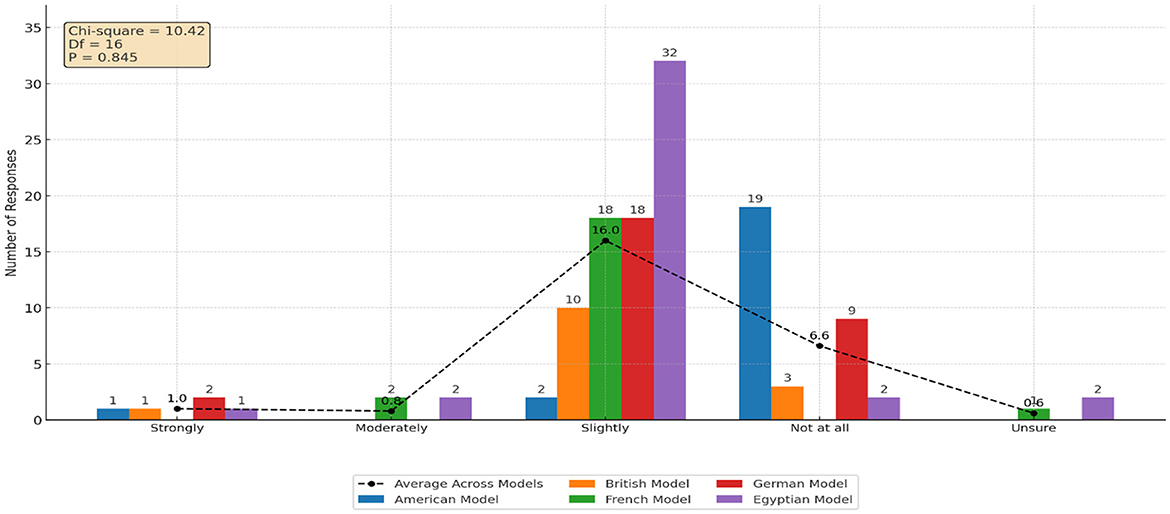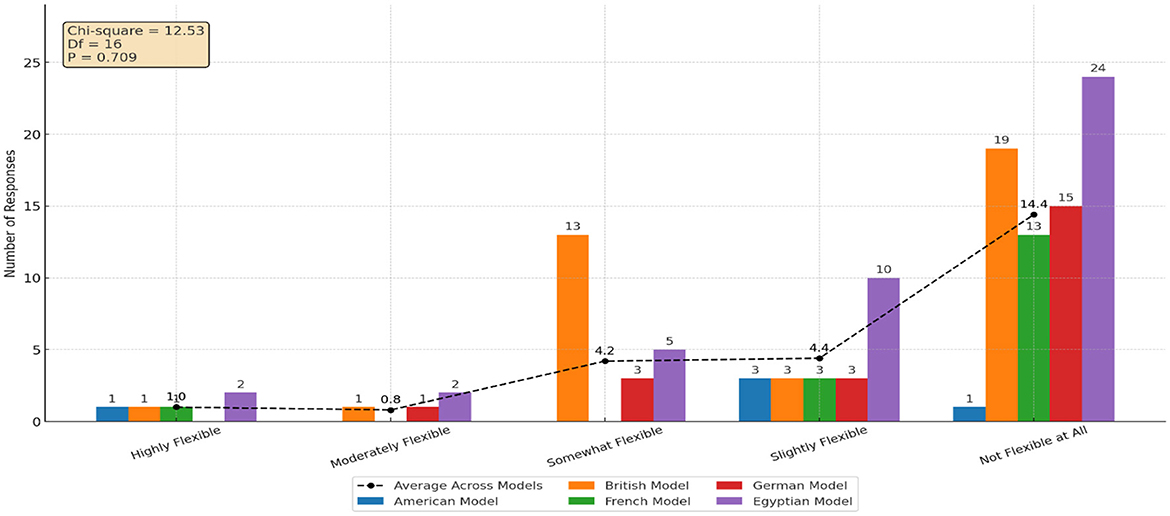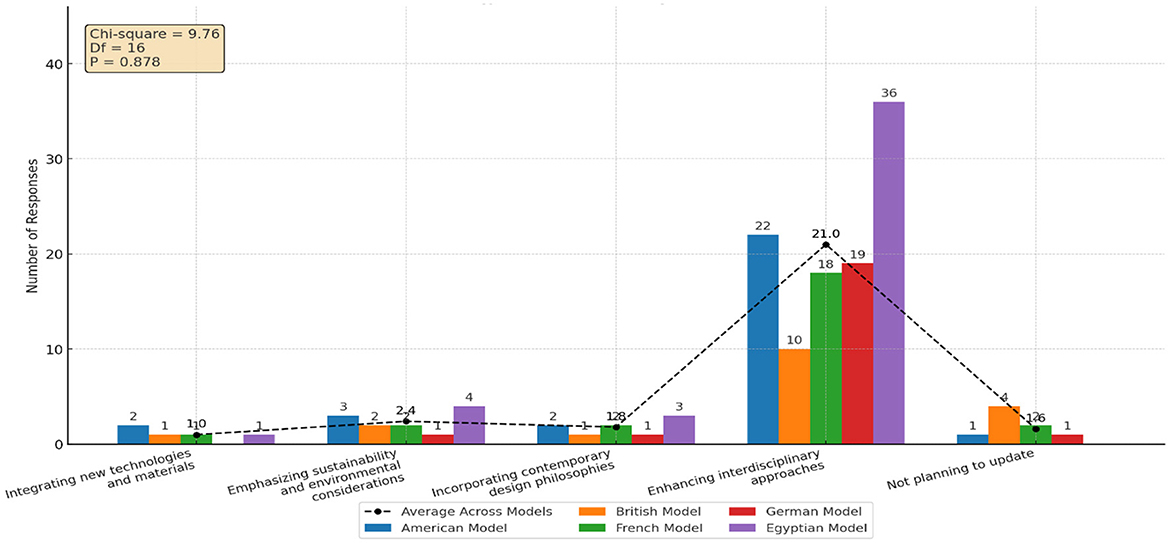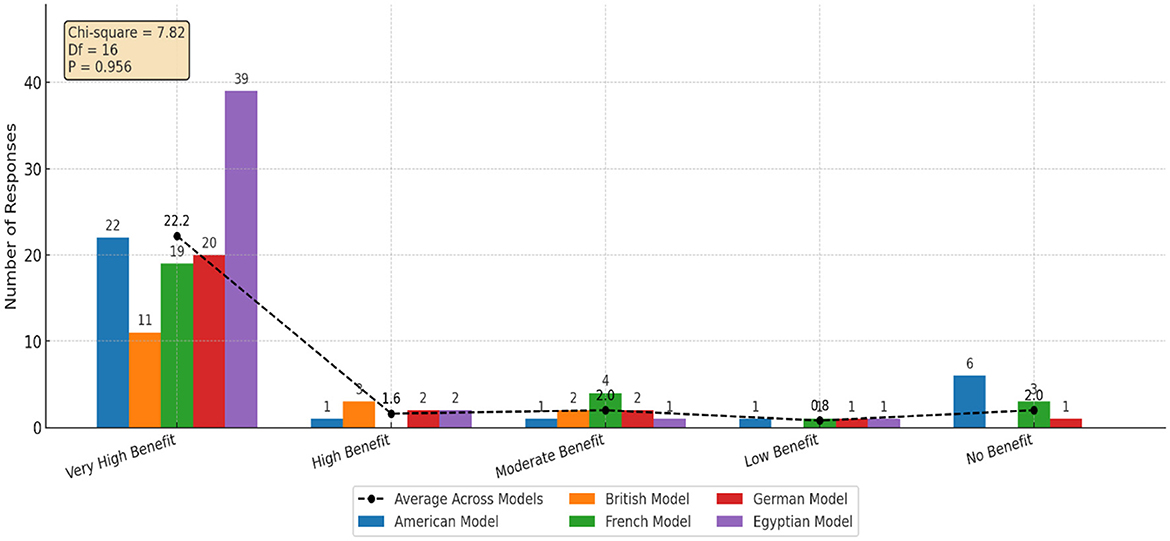- 1Department of Architecture, College of Engineering and Information Technology, Onaizah Colleges, Qassim, Saudi Arabia
- 2Architecture Department, Faculty of Engineering, Al-Azhar University, Cairo, Egypt
- 3Architectural Engineering Department, College of Engineering, Imam Mohammad Ibn Saud Islamic University (IMSIU), Riyadh, Saudi Arabia
Architectural education requires integrated methodologies. There is also significant variation in definitions, pedagogical ideologies, and curricular practices across institutions, indicating the need for a common framework that enables architecture schools to respond effectively to contemporary challenges. This study explores the possibility of reviving the Vitruvian model as a unified, adaptable, and evolving model for architectural pedagogy. A structured questionnaire was distributed to faculty members at five international architecture schools, representing the American, British, French, German, and Egyptian systems. In total, 136 valid responses were obtained and analyzed. Statistical analysis, including chi-square tests, revealed no significant correlation between academic status, years of experience, or interpretive preferences and the pedagogical model, suggesting that perspectives on architectural education transcend national boundaries. The findings highlight a contemporary reinterpretation of Vitruvian principles, emphasizing sustainability, interdisciplinary collaboration, and human-centered design as key elements of the architectural curriculum. This study clarifies how the Vitruvian triad can be reinterpreted to advance sustainability, interdisciplinarity, and human-centredness in architectural education, and translates these insights into studio-based practices that more closely align with professional practice.
1 Introduction
Architectural education in the twenty-first century is being reshaped by globalization (Senderos et al., 2025), by environmental imperatives (Hurlimann et al., 2024), and by increasing cross-cultural design practice (Kostopoulos, 2022). Yet, numerous studies confirm that architectural education suffers from fragmented pedagogical goals (Salama, 2015), and an uneven philosophical foundation (Andrews, 2022), particularly with regard to the consistent treatment of the absence of human-centered approaches as a foundation for design education (Pilat et al., 2022). This inconsistency presents a major challenge in establishing a shared language and mutual understanding of foundational principles, thereby hindering the development of a coherent framework responsive to professional and societal needs (Saleh et al., 2023). In this context, the present study revisits the Vitruvian model as a potential unifying paradigm (Pollio and Morgan, 1960). Rooted in the triad of firmitas (firmness), utilitas (utility), and venustas (beauty), it balances structural integrity (Cernaro et al., 2023), functional purpose, and aesthetic value within a single conceptual frame (Januszewski, 2024).
These principles remain relevant as institutions seek to integrate sustainability, interdisciplinarity, and human-centered thinking into coherent curricula (Zhong et al., 2022; Salama, 2015). According to Lowenthal (1985), disregarding the balance between heritage and contemporary needs undermines cultural identity and weakens the spatial meanings that communities attach to both historical and modern contexts. These principles remain relevant as institutions seek to integrate sustainability, interdisciplinarity, and human-centered thinking into coherent curricula (Zhong et al., 2022). According to Lowenthal (1985), disregarding the balance between heritage and contemporary needs undermines cultural identity and weakens the spatial meanings that communities attach to both historical and modern contexts (Lowenthal, 1985).
Parallel critiques highlight a persistent gap between academia and practice: for instance, architectural pedagogy has often been criticized for overlooking its civic and ethical responsibilities (Salama, 2015). At the same time, architectural education continues to struggle with aligning inherited disciplinary frameworks with contemporary demands, leading to what has been described as a structural detachment between schools and the profession (Madan and Mathur, 2025). Recentstudies have further emphasized the pressing need to integrate sustainability and digital transformation more explicitly into curricula (Cenk and Selçuk, 2025).
This complexity heightens the urgency for pedagogical models that connect inherited frameworks with present-day innovation (El Moussaoui and Krois, 2025). Against this backdrop, the present study examines whether the Vitruvian thought can provide integrative coherence in architectural education today. Focusing on faculty perspectives across five international systems, it pursues two objectives:
(1) To explore educators' views on how embedding Vitruvian principles might enhance pedagogical coherence and student engagement.
(2) To analyze perceptions of the model's relevance, applicability, and barriers to integration.
This paper aims to demonstrate how the Vitruvian model can be operationalized as a contemporary pedagogical framework that directly addresses three urgent needs in architectural education—sustainability, interdisciplinarity, and human-centeredness—while tightening the link between studio education and professional practice. We pursue this aim by (i) tracing how firmitas, utilitas, and venustas can be reinterpreted as structural–ecological responsibility, programmatic–societal usefulness, and culturally embedded aesthetic value; (ii) comparing how five educational traditions (American, British, French, German/Bauhaus, and Egyptian) currently encode these values in curricula and studio culture; and (iii) deriving implementable studio guidelines and assessment cues that align classroom practice with professional expectations (e.g., community engagement, performance-informed decision making, and ethical accountability). In doing so, the paper proposes a coherent, transferable template for curriculum design that reconnects the historic Vitruvian triad with the outcomes required for twenty-first-century architectural education and practice.
The remainder of this paper is structured as follows. Section 2 reviews the literature, identifying theoretical and empirical gaps that justify revisiting Vitruvian principles. Section 3 outlines the methodology, including sampling strategy, survey instrument, and statistical procedures. Section 4 presents the results, both descriptive and inferential. Section 5 discusses these findings in relation to existing research, emphasizing curricular implications. Finally, Section 6 concludes by summarizing the study's contributions to understanding how Vitruvian principles may be integrated into architectural pedagogy and suggesting directions for future research.
2 Literature review
The integration of research and design production into architectural education has long been debated, particularly in discussions on how design studios can simultaneously serve as sites of creative production and rigorous academic inquiry (Fraser, 1991). Some scholars frame architecture as an imaginative discipline grounded in intuition and creativity, while others emphasize its role as a professional field requiring systematic study and evidence-based practice (Salama, 2015). Traditional pedagogical approaches, which rely heavily on observation and intuition, have been shown to be limited when detached from empirical and contextual realities, including social and environmental dimensions (Sattrup, 2012).
Without incorporating community-based research, students often struggle to address the social and spatial complexities of practice (Thienen et al., 2023). This reinforces the need to reposition research as a core component of architectural education to bridge the persistent gap between academia and practice. On the technological front, architecture has historically regarded technology as a neutral tool rather than as a cultural or conceptual force (Grassini, 2023). Recent perspectives, however, challenge this assumption, recognizing technology as a driver of design thinking and professional practice (Kamble et al., 2023).
In 2025 Singun argued that, Contemporary scholarship warns that a purely technical framing of technology is increasingly outmoded, particularly given the complexities of integrating digital transformation and sustainability in architectural education (Singun, 2025). Zhong et al. (2022), review how biophilic design—not merely ornamental greenery—fundamentally reshapes architectural form and function through multi-dimensional engagement with nature Likewise, Guo (2024), highlights that immersive technologies such as AR and DVR reshape architectural pedagogy not merely through functionality, but by enriching the cultural and experiential dimensions of design learning.
Together, these debates underscore both the progress and persistent gaps in architectural education (Hui, 2024). Beyond technology, contemporary pedagogical models provide important insights for curriculum development (Kohale, 2025). Among these models, Constructivism, rooted in the work of Piaget, Vygotsky, and Dewey, frames learning as an active process of knowledge construction rather than passive reception (Chand, 2023). This perspective aligns closely with the design studio, where students learn through action, reflection, and collaboration (Chand, 2023). Buchanan (2012) critiques the traditional fragmentation of technical, historical, and design knowledge, instead advocating for integrative and experimental learning. Similarly, Kolb's experiential learning cycle emphasizes the iterative interplay between reflection, conceptualization, and practice, encouraging students to address real-world problems through applied inquiry (Healey and Jenkins, 2000).
Schön's concept of the reflective practitioner reinforces the American model of architectural education, positioning design as a process of inquiry, reflection, and adaptation (Schön, 1984). Complementing these, Bloom's Taxonomy provides a cognitive framework for cultivating higher-order thinking, visible in design studios when students synthesize structural, spatial, and environmental considerations into coherent proposals (Hui, 2024). Collectively, these models demonstrate how architectural education can cultivate critical judgment and adaptability, though many curricula remain overly reliant on studio culture without systematically embedding reflection, interdisciplinarity, or sustainability (Ng, 2020). Alongside these modern pedagogical theories, the historical roots of architectural education also remain central.
Vitruvius provides a historical foundation for these discussions (Gros, 2006). De-Architectura served as a manual on construction and materials and also addressed hydraulics, acoustics, and mechanics (Rapp, 2002). Rediscovered and expanded during the Renaissance by figures such as Barbaro and Palladio, it became a cornerstone of architectural pedagogy (Pollio et al., 1999). Since then, movements from the Beaux-Arts to Modernism have challenged or reinterpreted Vitruvius's framework, whose resilience lies in its balance of practice and theory (Cellauro, 2015). In his ten books, Vitruvius presents architecture as inherently interdisciplinary, integrating engineering, philosophy, history, and law (Oksanish, 2011).
He emphasized proportion, philosophical reflection, and modesty, while drawing on medicine and physics to inform knowledge of health and natural forces (Nichols, 2017).
Vitruvius's writings thus stress the importance of comprehensive education, positioning the architect as a mediator of technical, cultural, and civic values (Bianco, 2023). Vitruvius's ideas revolve around six basic principles:
• First, the trinity of stability, utility, and pleasure emphasized structural integrity, functionality, and aesthetic harmony (Vitruvius, 1914).
• Second, he promoted a holistic approach in which multiple disciplines shape form, ethics, and practice (McEwen, 2003).
• Third, he stressed interdisciplinary collaboration, highlighting the inseparability of architecture and engineering (Anthony, 1991).
• Fourth, he advocated integrating practical skills with theoretical knowledge, warning that theory without practice is merely “chasing shadows” (Wilson, 2022).
• Fifth, he underscored civic responsibility, framing architecture as a public duty directed toward society's health, safety, and wellbeing (Pollio, 2013).
• Finally, he reinterpreted aesthetic values, positioning architecture as a functional product rather than a purely external form (Grabow and Spreckelmeyer, 2015).
While architectural education issues have changed, the profession has evolved, and terminology and concerns have shifted over time, Vitruvius's synthesis of practice and theory continues to shape architectural discourse (Lefas, 2000). Architectural research has either debated or rejected his model, but its persistent presence at the heart of discussions testifies to its relevance and adaptability today (Weir, 2015). Despite this importance, there remains a lack of comparative analysis of how Vitruvian principles are reinterpreted in contemporary global curricula (Newman and Vassigh, 2016).
Addressing this gap requires situating the Vitruvian triad—firmitas, utilitas, and venustas—within diverse educational traditions to assess its continuing applicability. For this reason, the present study examines five representative models: French, British, Bauhaus, American, and Egyptian. The first four are well-established in the literature and provide historically significant approaches that continue to influence architectural education worldwide (Salama, 1995). By contrast, the Egyptian model has received comparatively limited scholarly attention; however, it reflects a regional manifestation that initially drew on French Beaux-Arts and British colonial frameworks, and later adapted elements of the American tradition within a Middle Eastern context (Dessouky, 2016). Its inclusion highlights how Vitruvian ideas, though mediated through imported frameworks, acquire distinctive local interpretations that reveal the dynamics of architectural education in non-Western settings. By situating these five models side by side, the study establishes a framework for evaluating whether Vitruvius's synthesis can serve as an effective foundation for addressing the pressing contemporary challenges of sustainability, interdisciplinarity, and human-centredness in architectural education.
2.1 Trajectories of formal architectural pedagogy across the five schools
After the previous review, to contextualize the present study, it is necessary to trace the historical development of architectural education and its most important methodological foundations through five main models that represent the case study: French, British, Bauhaus, American, and Egyptian. Each model reflects the social, political, and cultural conditions prevailing in its era, yet they all contributed to shaping the foundations of modern education in architecture schools (Salama, 2021). Building on the paper's purpose to connect Vitruvian principles with sustainability, interdisciplinarity, and human-centredness, the following section traces how each model encodes these values.
2.2 French model
The origins of formal architectural education are often traced to the Armstrong (2017), which laid the foundations for the Écoledes Beaux-Arts in Paris (Cret, 1941). Rooted in apprenticeship and the atelier system, the French model emphasized drawing, design competitions, and the study of classical precedent (Perkins, 1955; Gulgonen, 1982). By the 19th century, it had become closely tied to state institutions, elevating architecture as one of the fine arts (Van Zanten, 1988). Despite frequent criticism for academic elitism and detachment from modern needs (Durand, 2000), its atelier pedagogy persisted well into the 20th century. The upheavals of 1968 prompted a restructuring of the École, abolishing hierarchical structures while retaining aspects of atelier-based pedagogy, which remain influential today (Marinic and Meninato, 2022).
2.3 British model
In Britain, architectural education emerged more directly from professional practice (Howarth, 1959). The Royal Institute of British Architects (RIBA, 1834) institutionalized the profession, while the Architectural Association (AA, 1847) pioneered a student-led alternative to pupillage (Frattari, 2025). By the early 20th century, RIBA sponsored international congresses on pedagogy, while the AA became a hub of modernist reform, producing experimental groups such as Archigram (Waite, 2021). Under Alvin Boyarsky in the 1970s, the Architectural Association (AA) was transformed into an international cultural institution, attracting renowned architects as tutors and promoting a modernist, experimental trajectory with little remaining influence of Beaux-Arts traditions (Krauss, 1985).
2.4 Bauhaus model (Germany)
The Bauhaus (1919–1933) synthesized art, craft, and technology, reshaping design pedagogy worldwide (Bayer et al., 1938). Early influences from the Arts and Crafts movement evolved toward industrial orientation, emphasizing workshop-based learning and the integration of engineering and modern materials (Dearstyne, 1962; Edwards, 2019). Even after its closure, Bauhaus principles—particularly the Vorkurs foundation course—were disseminated globally and adapted in architecture and design schools (Chen and He, 2013; Sadowski, 2021). The Bauhaus's emphasis on simplicity, economy, and mass production left a legacy on modern architecture and design education (Pane, 2018).
2.5 American model
The U.S. developed a hybrid system influenced by both French and British traditions. William Robert Ware established the first American schools of architecture at MIT (1865) and Columbia (1871) (Chewning, 1986), adapting Beaux-Arts pedagogy to the university setting (Anderson, 1999). Over time, American schools increasingly emphasized scientific and technical studies, introducing graduate degrees as early as 1878 at the University of Illinois under Ricker's leadership, which combined academic study with professional practice (Block, 2019).
By the late 20th century, Donald Schönreframed architectural pedagogy through “reflection-in-action” and “design reasoning,” shifting focus from artifact production to cognitive processes, and advocating the integration of artistry, applied science, and reflective studio practice (Schön and Wiggins, 1992; Perkins, 1955). This perspective aligns most closely with the American model of architectural education, where the design studio is conceived as a laboratory for inquiry, iteration, and adaptation. Within this model, students are expected to “think in action,” engaging in cycles of experimentation that bridge theory and practice while developing professional judgment. In contrast, the French, British, and Bauhaus models were historically grounded in formal curricula, stylistic canons, or workshop training, where reflection played a secondary role to mastery of established techniques. Similarly, the Egyptian model, while drawing on European and American influences, remains constrained by prescriptive structures and has not widely institutionalized Schön's reflective paradigm. For this reason, Schön's approach is particularly suited to the American context but less directly transferable to the other models investigated in this study.
2.6 Egyptian model
In Egypt, architectural education evolved as part of the state-led modernization of higher education in the early 20th century. The Faculty of Engineering at Cairo University, established in 1908, integrated French Beaux-Arts traditions with British frameworks, resulting in hybrid curricula shaped largely by external influences (Aoun and Hassan, 2016). In subsequent decades, architectural schools expanded in public universities such as Ain Shams and Alexandria, gradually institutionalizing architecture as both a technical and cultural discipline (Ismail et al., 2025). While documented to some extent, it remains underrepresented in the literature and is treated here as a regional practice that later absorbed aspects of the American studio system, offering a Middle Eastern perspective on the reinterpretation of Vitruvian principles. Salama highlights how this system developed within Arab and Islamic traditions while simultaneously engaging with European and international models (Salama, 2007). Later reforms were shaped by globalization, informality, and the challenges of rapid urbanization (Salama, 2007). This trajectory underscores the adaptation of imported models to local socio-cultural realities, while also highlighting the tension between globalized standards and national development priorities (Dessouky, 2016).
These five trajectories reveal that architectural education is historically contingent, shaped by political, cultural, and socioeconomic forces (Jones, 2009). However, the focus on the French, British, Bauhaus, American, and Egyptian traditions necessarily excludes other influential perspectives, such as the German polytechnic model, Scandinavian humanist approaches, Latin American frameworks of social responsibility, and contemporary Asian curricula. As Pallasmaa (2012), emphasizes, architectural education worldwide has evolved through diverse trajectories shaped by cultural and epistemological priorities, while comparative studies in Asia according to Porras Álvarez et al. (2016), and Nordic-Baltic contexts (Santanicchia, 2020), further highlight alternative models beyond the Western canon. Similar discussions in Latin America demonstrate how architectural education increasingly integrates sustainability and social responsibility (Martínez-Ventura et al., 2021). Acknowledging these omissions, this study positions its scope as selective rather than exhaustive and treats the exclusion of such perspectives as a limitation that may be addressed in future research.
From the French atelier and British professional reforms to the Bauhaus synthesis of art and design, the American hybrid model, and Egypt's efforts to reconcile global frameworks with local realities, each tradition illustrates the interplay between imported models and contextual requirements (Dessouky, 2016).
See Table 1 which summarizing key aspects of the French, British, Bauhaus, U.S.A. and Egyptian models of architectural education.
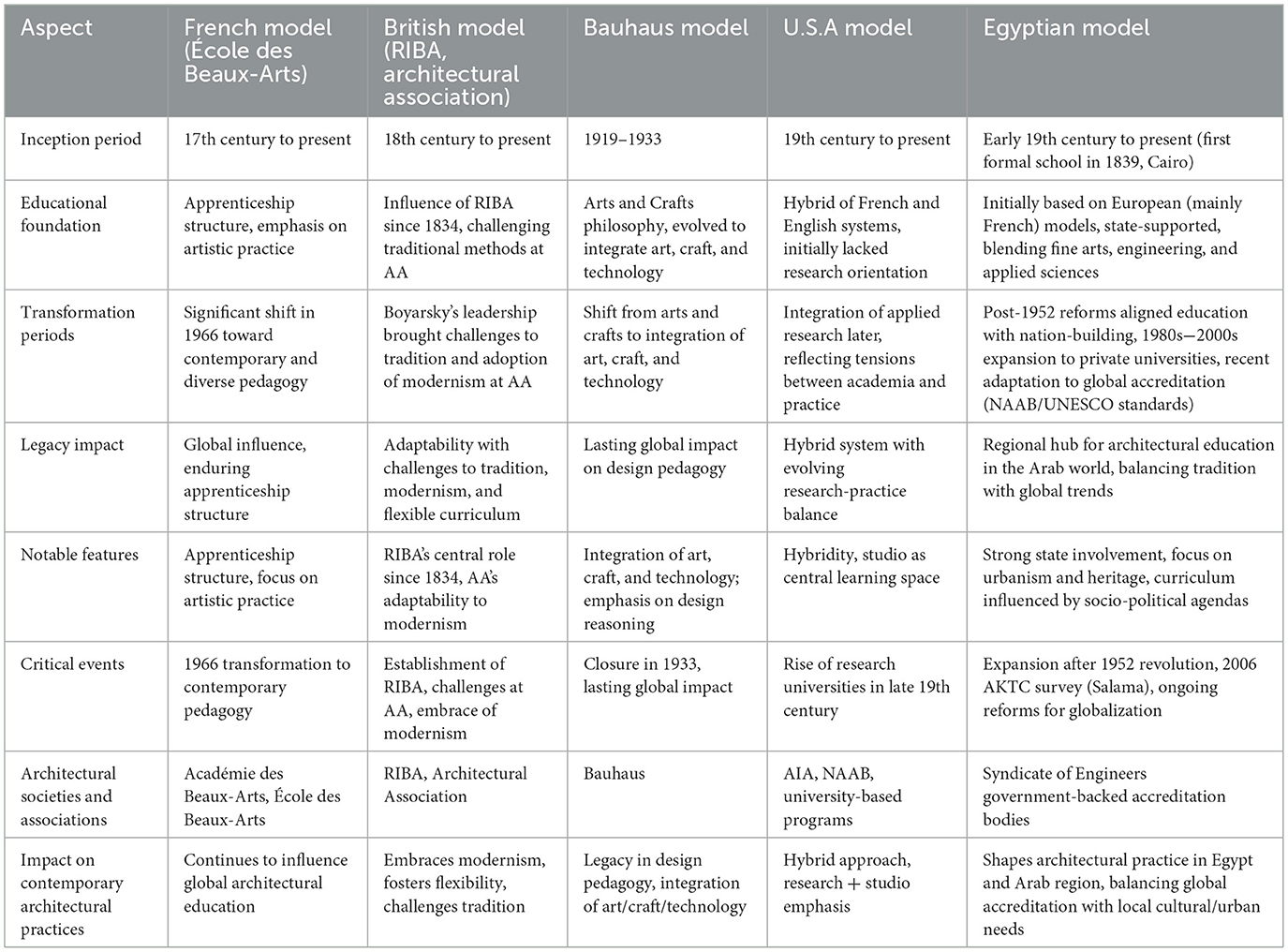
Table 1. Summarizing key aspects of the French, British, Bauhaus, U.S.A and Egyptian models of architectural education.
2.7 Research gap and contribution
This study adds to the scholarship on architectural education by revisiting the Vitruvian model and testing its relevance across five educational traditions: French, British, Bauhaus, American, and Egyptian. Previous research has often looked at these models separately or from a purely historical angle, but little attention has been given to how they overlap today or how Vitruvian ideas could work as a shared framework. The value of this study is in connecting the historical roots of architectural thought with current challenges such as sustainability, digital transformation, and human-centered learning. Drawing on insights from academic professionals, the research offers a comparative perspective that links philosophy with practice and points toward a more coherent, adaptable, and inclusive approach to teaching architecture.
3 Methods
This study adopts a mixed-method comparative design that integrates historical analysis with empirical data collection. A literature review was conducted to identify contemporary challenges in architectural education, and a comparative historical review was employed to trace the evolution of architectural education across five traditions—French, British, Bauhaus, American, and Egyptian—highlighting their turning points, philosophical orientations, and pedagogical impact.
Based on this foundation, a structured questionnaire was developed and presented to five architectural schools to assess the relevance of contemporary Vitruvian thought. The questionnaire was initially designed with 24 closed questions and reviewed by 12 experts in architectural education to ensure clarity, alignment with the research objectives, and coverage of emerging issues such as sustainability, technology, and interdisciplinary collaboration. This approach aligns with established frameworks that emphasize expert validation as a fundamental step to improving content accuracy and reducing measurement errors in survey instruments (Ikart, 2019).
Based on expert feedback, the questionnaire was refined to include 16 closed questions and one open-ended question and then validated through a second pilot with nine experts. This iterative process enhanced the instrument's clarity, efficiency, and validity, while also enabling it to incorporate nuanced qualitative insights. The final questionnaire was distributed to five universities and received 136 valid responses (59% response rate) from academics and experts.
Quantitative data were processed using SPSS, applying descriptive statistics (frequencies, percentages, and cross-tabulations) and exploratory comparisons across the five educational models to identify prevailing patterns and differences. Responses to the open-ended question were analyzed through manual thematic analysis, clustering recurring concepts related to pedagogy, curriculum, and professional practice. The integration of statistical and thematic analyses ensured methodological triangulation, linking historical trajectories to contemporary academic perspectives, and providing a solid empirical basis for reinterpreting Vitruvian principles within a globalized, technology-driven educational framework.
This approach allows respondents the freedom to express their opinions, which was essential in collecting diverse responses from educators at five prestigious universities:
▪ University of Illinois at Urbana-Champaign.1
▪ Liverpool School of Architecture.2
▪ École Nationale Supérieure d'Architecture de Paris-Belleville (ENSA Paris-Belleville).3
▪ ETH Zurich (FederalInstitute of Technology Zurich).4
▪ Al-Azhar University.5
3.1 Institutional representation and theoretical alignment
As shown in Table 2, each institution was selected after a comprehensive review of its official academic curricula and the educational philosophies published on its websites. Methodologically, this review was integrated into the comparative design of the study: the curricula were analyzed to identify structural features such as credit distribution, studio requirements, and research integration, while the stated philosophies were examined to clarify each school's pedagogical orientation. This dual review ensured that institutional selection was consistent with the study's aim of tracing how different educational traditions reinterpret Vitruvian principles in contemporary contexts.
This review confirmed that each university sufficiently aligns with the issues raised in the research, justifying its inclusion as representative case studies in the comparative framework.
All demographic items were included to capture the diversity of academic backgrounds and teaching experiences, ensuring that the analysis reflects multiple perspectives on architectural education. The questionnaire focused on how Vitruvian principles can be interpreted within contemporary curricula, probing perceptions of effectiveness, sustainability, challenges, and future directions.
3.2 Statistical methods used
Statistical analysis was conducted using IBM SPSS (IBM Corp, 2022), under the supervision of a professional statistician to ensure accuracy and reliability (see Appendix 2). A two-tiered approach was adopted. Descriptive statistics (frequencies, percentages, means, standard deviations) were used to summarize response patterns and highlight variability in perceptions of Vitruvian principles. Inferential analysis was carried out using Chi-square tests to examine associations between respondents' educational backgrounds and their views on integrating the Vitruvian model into contemporary curricula. Significance levels (p-values) were reported to validate the strength of observed relationships. This rigorous framework ensured that both distributional trends and meaningful associations were captured, supporting robust conclusions on the relevance of classical principles in modern architectural education.
3.3 Justification of sample size and representativeness
The total estimated number of full-time faculty across the five selected universities—University of Illinois at Urbana-Champaign, Liverpool School of Architecture, École Nationale Supérieure d'Architecture de Paris-Belleville, ETH Zurich, and Al-Azhar University—was approximately 214. Based on this, and using Taro Yamane's formula at a 95% confidence level and a 5% margin of error, the minimum required sample size was calculated as: n = N/(1 + N * e2) (Slovin, 1960), = 214/(1 + 214 * 0.052) ≈ 139. The study obtained 136 valid responses, representing 63.5% of the population, which is statistically robust and sufficiently representative despite being slightly below the threshold. All analyses report significance levels (p-values), reinforcing the reliability of the findings.
4 Results
Full statistical details, including observed and expected frequencies, Chi-square values, and significance levels, are provided in Appendix 2.
4.1 Demographics (Q.1, Q.2)
The distribution of academic ranks among respondents is illustrated in Figure 1, and as presented in Appendix 2-Q.1, Associate Professors constituted the largest share of respondents (33.8%), followed by Assistant Professors (24.3%) and Professors (16.9%). The Egyptian model accounted for the largest proportion of total responses, yet the Chi-square test of independence showed no statistically significant association between academic position and educational model (χ2 = 20.19, df = 16, p = 0.213). This outcome indicates that the distribution of academic ranks is broadly comparable across the five educational systems examined. The higher representation of mid- to senior-level staff may suggest that these groups play a more prominent role in curricular and institutional matters; however, this interpretation should be treated cautiously, as the survey did not directly assess such responsibilities.
4.2 Years of experience (Q.2)
The variation in teaching experience across different universities is presented in Figure 2, and as detailed in Appendix 2-Q.2, most participants reported extensive teaching experience: 24.3% had taught for 11–20 years, while 16.9% had more than 20 years of experience. In contrast, only 1.5% reported less than 1 year of academic experience, indicating that the dataset largely reflects the perspectives of mid- to late-career faculty.
A chi-square test of independence revealed no statistically significant association between teaching experience and the instructional model (χ2 = 2.63, df = 16, p = 0.998), suggesting that teaching experience is similarly distributed across the five systems. Although differences between models were minimal, the strong representation of experienced faculty provides important context for interpreting the results, as these participants are likely to possess substantial familiarity with curricular and institutional practices. This, in turn, enhances the robustness and credibility of the study's findings.
4.3 Beliefs and ideologies (Q.03, Q.04)
Interpretations of the Vitruvian principle of Firmness are shown in Figure 3. Question 3 asked whether respondents consider the Vitruvian model valid in today's architectural education and practice. The majority (33.82%) selected “strongly yes,” with an additional 19.12% choosing “somewhat,” signaling partial but favorable agreement. Smaller proportions expressed uncertainty (16.18%) or disagreement (16.91%), while 13.97% answered simply “yes” without strong emphasis. Taken together, these findings suggest that Vitruvian principles continue to resonate strongly in contemporary architectural discourse, though with varying degrees of conviction. A Chi-square test of independence was conducted to assess whether these views differed across educational models (see Appendix 2, Table Y). The results showed χ2 = 0.20, df = 16, p = 0.99, confirming no statistically significant variation between groups.
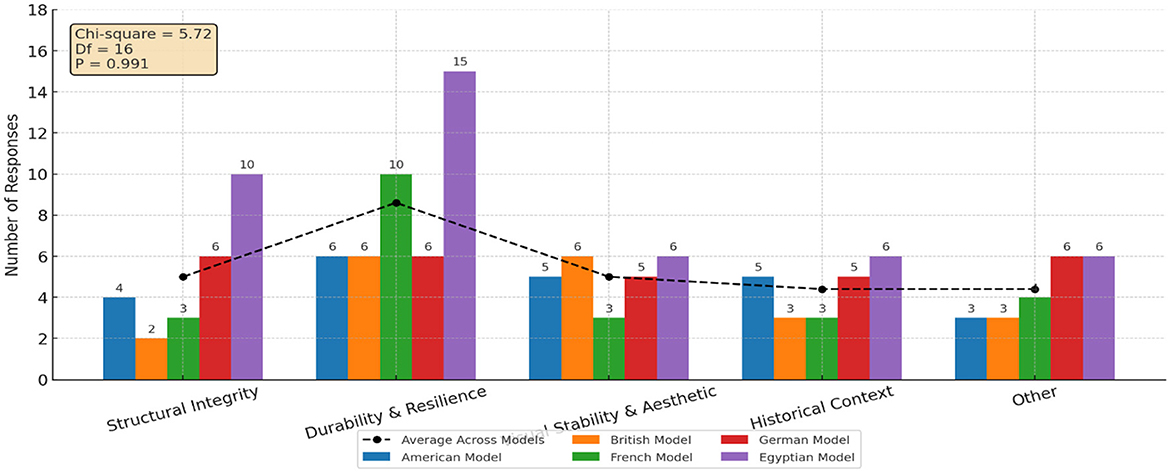
Figure 3. Results for Q.3 results. Presents participants' interpretations of the concept of “firmness” in their teaching philosophy.
This consistency indicates that perspectives on the Vitruvian framework are broadly aligned across American, British, French, German, and Egyptian contexts. The convergence of support across these diverse systems underscores that Vitruvius's triad remains a shared pedagogical and theoretical reference point, transcending formal curricular boundaries and reinforcing its universality in architectural education.
The conceptual understanding of Commodity is represented in Figure 4, Question 4 asked whether respondents consider the Vitruvian model valid in today's architectural education and practice. The majority (33.82%) selected “strongly yes,” with an additional 19.12% choosing “somewhat,” signaling partial but favorable agreement. Smaller proportions expressed uncertainty (16.18%) or disagreement (16.91%), while 13.97% answered simply “yes” without strong emphasis. Overall, these findings suggest that Vitruvian principles continue to resonate strongly in contemporary architectural discourse, though with varying degrees of conviction.
A Chi-square test of independence was conducted to examine whether these views varied across different educational models (see Appendix 2, Table Y). The results showed χ2 = 0.20, df = 16, p = 0.99, confirming no statistically significant differences between groups.
This consistency indicates that perspectives on the Vitruvian framework are broadly aligned across American, British, French, German, and Egyptian contexts. The convergence of support across these diverse systems underscores that Vitruvius's triad remains a shared pedagogical and theoretical reference point, transcending formal curricular boundaries and reinforcing its universality in architectural education.
4.4 Teaching methods (Q.05, Q.06, Q.07)
Perceptions related to Delight as an architectural value are summarized in Figure 5. Question 5 asked respondents which aspects of Vitruvian thought they incorporate in their teaching. The majority (64.71%) selected “all of the above,” indicating a preference for a holistic approach that integrates firmness, commodity, and delight simultaneously. Individual aspects were chosen far less frequently: delight (14.03%), commodity (11.76%), and firmness (6.62%). Only 2.94% reported that they do not incorporate Vitruvian elements at all. A Chi-square test of independence was conducted to examine whether the distribution of responses varied across different educational models (see Appendix 2, Table X). The test results showed χ2 = 0.065, df = 16, p = 0.999, confirming no statistically significant differences between groups. This indicates that educators across American, British, French, German, and Egyptian systems demonstrate remarkably consistent preferences.
This lack of variation suggests a global pedagogical convergence around the Vitruvian triad, with most educators favoring comprehensive integration rather than isolated emphasis. At the same time, the triad appears to be reinterpreted flexibly to accommodate contemporary priorities such as sustainability, interdisciplinarity, and human-centered pedagogy.
4.5 Q6. Effectiveness of utilizing Vitruvian principles in pedagogical approaches
Figure 6 demonstrates the relationship between theoretical courses and design studio applications. Question 6 explored how effective respondents perceive the use of Vitruvian principles in teaching. Nearly half (45.59%) rated the approach as very effective, while a further 22.06% described it as effective. Together, these categories represent 67.65% of all responses, underscoring strong support for the model as a pedagogical tool. By contrast, 12.50% considered it ineffective, and fewer than 1% rated it very ineffective. A neutral position was reported by 19.12% of respondents. The influence of contextual factors on architectural curricula is depicted in Figure 7. A Chi-square test of independence was conducted to examine whether these perceptions varied across different educational systems (see Appendix 2, Table Z). The results produced χ2 = 0.212, df = 16, p = 0.999, confirming no statistically significant differences between groups. This indicates that respondents across American, British, French, German, and Egyptian systems share a consistent view of Vitruvian principles as pedagogically effective. From a pedagogical perspective, this consensus affirms the enduring adaptability of Vitruvian thought. The triadic balance of structure, function, and aesthetics continues to provide a meaningful and globally relevant framework for guiding students in design education.
4.6 Q7. Frequency of incorporating sustainability discussions in teaching
Question 7 asked about the extent to which sustainability is embedded in teaching practice. The most common response was rarely (33.82%), followed by never (20.59%) and sometimes (25.74%). Only a minority reported often (11.03%) or very often (8.82%) integrating sustainability into pedagogy.
A Chi-square test of independence was conducted to examine whether the frequency of sustainability discussions differed across educational systems. The results returned χ2 = 0.00, df = 16, p = 1.000, indicating no statistically significant variation between groups. This uniformity suggests that respondents across American, British, French, German, and Egyptian systems share similar patterns of practice. While the consistency indicates alignment across systems, the substantive result is concerning: sustainability remains insufficiently prioritized in architectural pedagogy worldwide. These findings highlight a critical misalignment between global sustainability imperatives and current teaching practices, underscoring the urgent need for curricular reform and faculty development to better prepare students for the environmental and ethical challenges of 21st-century practice.
4.7 Q8. Most effective teaching method in architectural education
Question 8 asked respondents to identify the most effective teaching method in architectural education. The majority (65.44%) selected studio-based learning, strongly reinforcing the studio's position as the pedagogical core of architectural education worldwide. Other methods—lectures/seminars (9.56%), interactive workshops (9.56%), field trips (8.09%), and online modules (7.35%)—were much less frequently endorsed, confirming their supplementary rather than central role in cultivating architectural competence.
Figure 8 presents students' views regarding the integration of sustainability principles. A Chi-square test of independence was conducted to examine whether teaching method preferences varied across educational systems (see Appendix 2, Table BB). The results showed χ2 = 0.00, df = 16, p = 1.000, indicating no statistically significant differences between groups. This demonstrates that across American, British, French, German, and Egyptian systems, educators share a consistent view of studio-based learning as the pedagogical core.
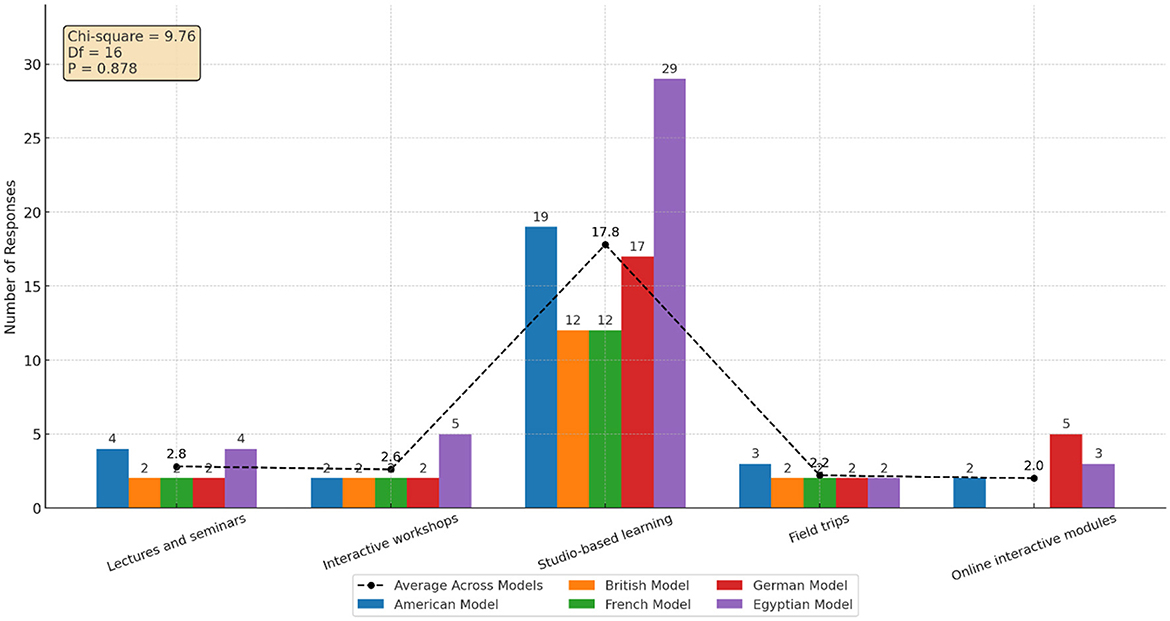
Figure 8. Q.8 results. Shows the frequency of discussing sustainability in the context of Vitruvian principles.
This global consensus underscores the enduring centrality of studio pedagogy. Despite increasing technological diversification, the studio continues to provide the most effective environment for integrating theory, practice, critique, and creativity, and for cultivating critical thinking and spatial reasoning in architectural education.
4.8 Q9. Extent of curricular incorporation of Vitruvian principles
Question 9 examined the extent to which Vitruvian principles are explicitly embedded in curricula. Over half of respondents (54.41%) reported they are “slightly” incorporated, and 27.21% said they are “not at all.” By contrast, only small minorities reported strong (5.15%) or moderate (7.35%) incorporation, while 5.88% were unsure. This distribution suggests that although Vitruvian concepts remain influential in architectural discourse, they are rarely formalized within curriculum structures. The balance between global architectural trends and local identity is visualized in Figure 9.
A Chi-square test of independence was conducted to examine whether incorporation levels differed across educational systems (see Appendix 2, Table CC). The results showed χ2 = 0.889, df = 16, p = 0.999, indicating no statistically significant association between groups. This finding suggests that the limited curricular integration of Vitruvian principles is a global trend rather than one confined to particular traditions.
From a pedagogical perspective, this reflects how Vitruvian principles often operate as implicit cultural values rather than explicit curricular frameworks. The predominance of “slight” or “none” represents a missed opportunity: embedding the triad more deliberately could connect historical theory with pressing contemporary challenges such as sustainability, structural innovation, and human-centered design.
4.9 Q10. Flexibility of curriculum content in relation to Vitruvian principles
Question 10 investigated curricular flexibility in accommodating Vitruvian principles. More than half of respondents (52.94%) described their curricula as “Not Flexible at All.” Only small minorities reported higher levels of adaptability: Highly Flexible (4.41%), Moderately Flexible (5.15%), Somewhat Flexible (18.38%), and Slightly Flexible (19.12%). These results underscore a prevailing rigidity, with the integration of Vitruvian ideas limited and often informal.
Cross-model comparisons suggested some variation: the American and French systems recorded the highest “Not Flexible at All” responses, while the British system reported relatively more “Somewhat Flexible” answers, indicating a degree of adaptability. However, a Chi-square test of independence (see Appendix 2, Table DD) indicated no statistically significant differences between educational models, χ2 = 0.405, df = 16, p = 0.99. This confirms that curricular inflexibility is a systemic global issue rather than a model-specific one.
Comparative results concerning digital design tools usage appear in Figure 10. From an educational perspective, these findings highlight the need for curricular reform to enhance flexibility and interdisciplinarity. Greater adaptability would enable enduring frameworks such as Vitruvius' triad to be more effectively integrated into architectural education, connecting historical principles with contemporary pedagogical priorities.
4.10 Q11. Relevance of Vitruvian principles to achieving sustainability
Figure 11 illustrates respondents' opinions about interdisciplinary collaboration in architecture, and Question 11 asked whether Vitruvian principles are relevant to achieving sustainability in architectural education. A strong consensus emerged: 66.18% strongly agreed and 13.97% agreed, meaning nearly 80% of respondents endorsed the triad as supportive of sustainability objectives. Neutral (5.88%), disagree (8.09%), and strongly disagree (5.88%) responses were comparatively rare, suggesting limited skepticism. Cross-model analysis showed that the Egyptian system recorded the highest share of “Strongly Agree” responses, followed by German and American institutions, though all five models displayed broadly consistent support. A Chi-square test of independence (see Appendix 2, Table EE) confirmed no statistically significant differences between educational systems, χ2 = 0.017, df = 16, p = 0.999. This consistency suggests that recognition of Vitruvian principles as supportive of sustainability is shared across global contexts.
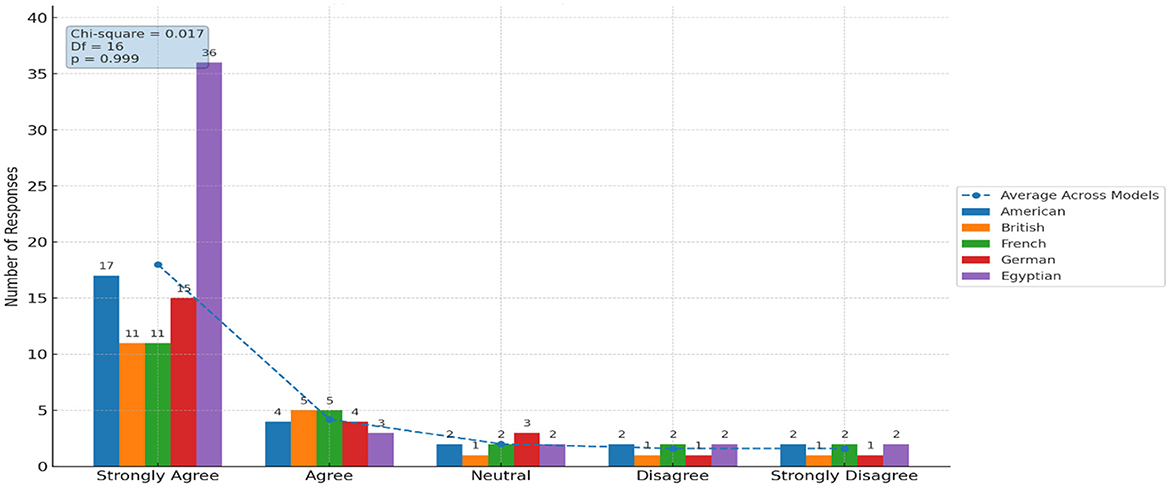
Figure 11. Results for Q11: applying Vitruvius' principles for sustainability across educational models.
Pedagogically, these findings indicate that far from being obsolete, Vitruvius' framework is being reinterpreted for 21st-century challenges. Its triadic balance—structural integrity, functional adaptability, and aesthetic value—aligns closely with ecological and human-centered imperatives, reinforcing its relevance for contemporary architectural curricula.
4.11 Q12. Is applying Vitruvius' principles in the curriculum merely nostalgic?
Question 12 investigated whether integrating Vitruvian principles into curricula is perceived as an act of nostalgia. The overwhelming majority rejected this notion: 61.76% selected Strongly Disagree and 28.68% Disagree, totaling over 90% opposition to the “nostalgia” claim. Only small minorities responded otherwise: Agree (3.68%), Strongly Agree (2.21%), and Neutral (4.41%).
Figure 12 shows faculty perceptions of research-based learning approaches. Cross-model analysis revealed that Egyptian, French, and German respondents most frequently selected Strongly Disagree, while American and British respondents—though slightly more distributed—still leaned toward rejecting the nostalgia interpretation. A Chi-square test of independence (see Appendix 2, Table FF) confirmed no statistically significant variation between systems (χ2 = 0.196, df = 16, p = 0.999). Pedagogically, these findings demonstrate that Vitruvian thought is not regarded as a relic of the past but as a body of adaptable, contextually rich principles that retain strong relevance for contemporary architectural education and practice.
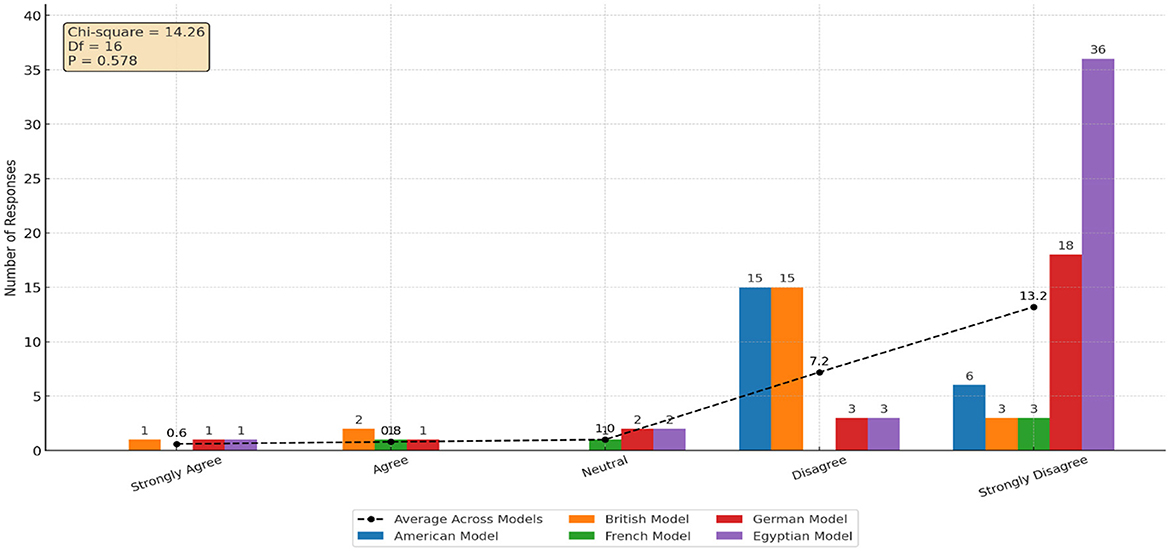
Figure 12. Results for Q12: nostalgic perception of Vitruvian principles in architecture curriculum.
Pedagogically, these findings reinforce that Vitruvian thought is not viewed as nostalgia but as a set of adaptable, contextually rich principles that retain relevance for contemporary architectural education and practice.
4.12 Q13. Challenges in incorporating the Vitruvian model
Question 13 examined the barriers educators face in integrating Vitruvian principles into teaching. Institutional resistance emerged as the most dominant challenge, reported by nearly two-thirds of respondents (63.97%). This finding indicates that obstacles are primarily structural and administrative rather than philosophical.
The second most frequent challenge was lack of student interest (19.12%), particularly notable in the Egyptian and German contexts. This suggests that while educators continue to value Vitruvian ideas, students may struggle to perceive their relevance to contemporary issues unless the principles are reframed. Other reported challenges included rigid program organization rules (8.09%), difficulty connecting Vitruvian principles to modern practice (5.88%), and insufficient resources or materials (2.94%).
The evaluation of creative thinking outcomes across institutions is displayed in Figure 13. A Chi-square test of independence (χ2 = 2.384, df = 16, p = 0.999) confirmed no statistically significant variation between educational models, indicating that these challenges are systemic rather than context-specific. Pedagogically, this highlights that limitations lie not in Vitruvian theory itself but in institutional frameworks. Addressing these barriers will require curricular reform, stronger administrative support, and innovative pedagogical strategies that explicitly connect Vitruvian concepts to sustainability, interdisciplinarity, and contemporary practice.
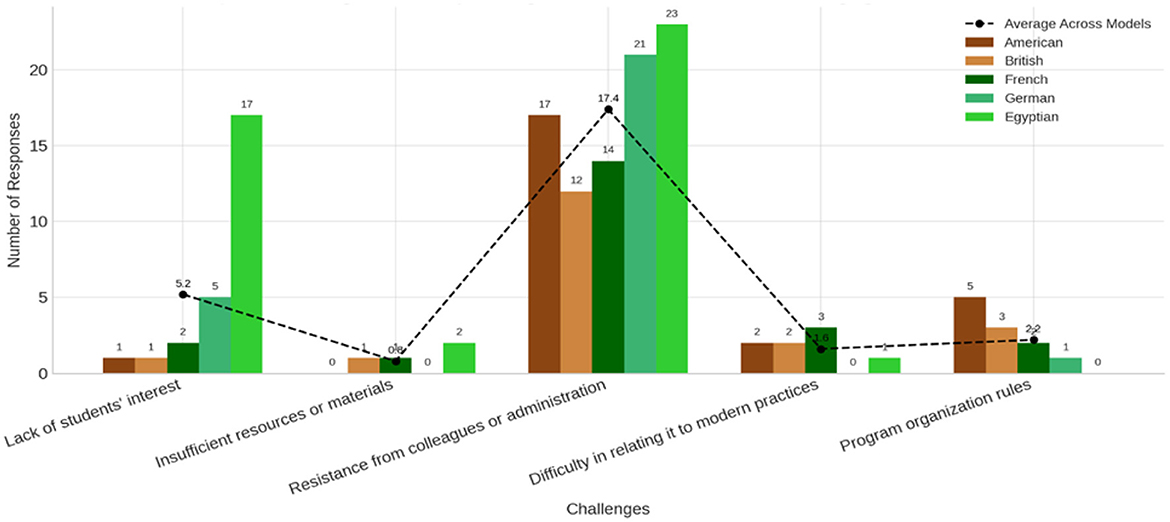
Figure 13. Results for Q13: challenges in incorporating the Vitruvian model into pedagogical practices.
4.13 Q14. How the Vitruvian model addresses contemporary architectural challenges
Question 14 investigated how the Vitruvian model is perceived as addressing contemporary challenges in architectural education. The majority of respondents (66.18%) selected All of the above, signaling broad recognition that Vitruvian principles remain relevant for promoting holistic architectural understanding, integrating sustainability into design practice, fostering interdisciplinary collaboration, and providing historical context to inform modern practice. Among the individual options, providing historical context received the highest proportion (14.71%), followed by Holistic understanding (7.35%), Sustainability integration (5.88%), and Interdisciplinary collaboration (5.88%). This distribution indicates that while individual dimensions are valued, most educators favor a comprehensive approach to applying the Vitruvian framework. Figure 14 represents the frequency of curriculum review and development cycles.
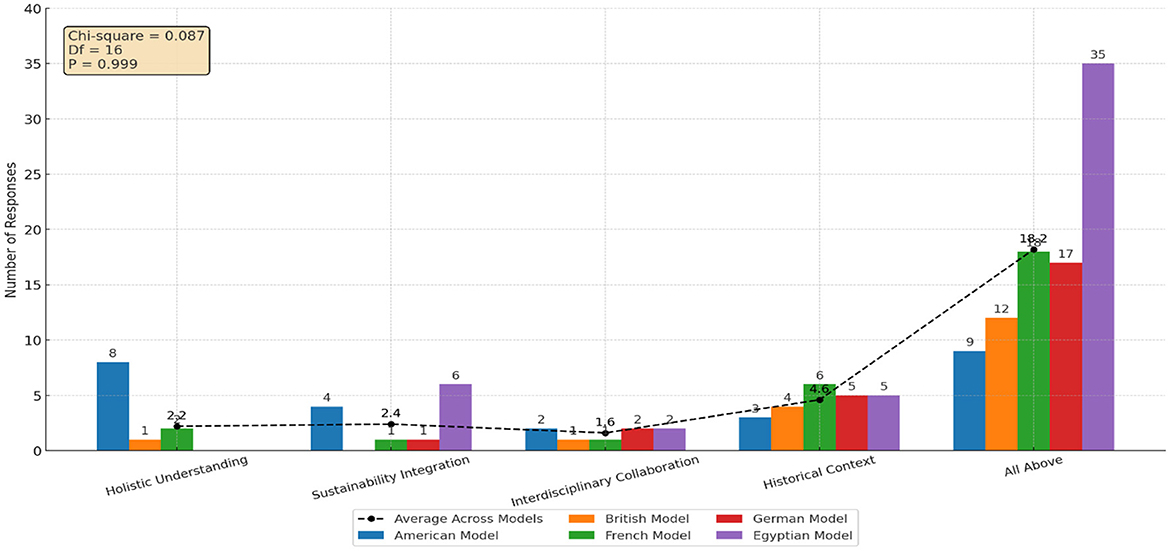
Figure 14. Results for Q14: how the principles of the Vitruvian model help address contemporary challenges.
Consistency across systems was evident, with particularly strong endorsement from Egyptian, French, and German respondents. A Chi-square test of independence (χ2 = 0.087, df = 16, p = 0.999) confirmed no statistically significant variation between educational models. Pedagogically, these findings underscore the adaptability of Vitruvian thought as a conceptual bridge between tradition and innovation. In the face of ecological, cultural, and technological pressures, the Vitruvian triad continues to provide a timeless yet flexible framework for reflective and sustainable pedagogy.
4.14 Q15. Updating or modernizing the Vitruvian model
Question 15 examined how the Vitruvian model might be modernized for contemporary architectural education. The responses revealed a strong global consensus around interdisciplinary enhancement: most respondents (77.94%) selected Enhancing interdisciplinary approaches, underscoring that educators see the future of pedagogy in cross-disciplinary integration—linking architecture with engineering, digital technology, environmental sciences, and the social sciences. Figure 15 summarizes the level of institutional support for pedagogical innovation.
Other options were endorsed less frequently: Incorporating contemporary design philosophies (6.62%), Emphasizing sustainability (5.88%), and Integrating new technologies and materials (4.41%). Only 5.15% selected No updates required, reflecting minimal support for preserving the Vitruvian model without adaptation.
A Chi-square test of independence (χ2 = 6.57, df = 16, p = 0.987) confirmed no statistically significant variation across educational systems, indicating broad alignment in views.
Educationally, these findings highlight that the Vitruvian triad—firmitas, utilitas, venustas—is not regarded as a static historical doctrine but as a dynamic framework to be extended into ecological, technological, and socio-cultural domains. Modernization, therefore, lies not in replacing Vitruvian thought but in reinterpreting and embedding it within interconnected 21st-century frameworks.
4.15 Q16. Student benefits of learning the Vitruvian model
Question 16 investigated the perceived benefits of teaching Vitruvian principles to students. Results revealed overwhelming support: 81.62% of respondents reported Very High Benefit and 6.62% High Benefit. Taken together, nearly 90% affirmed that engaging with the Vitruvian framework provides substantial value for students. Minority responses included Moderate Benefit (5.15%), Low Benefit (2.94%), and No Benefit (3.68%). The strongest support was reported by American, French, and Egyptian respondents, though all five educational systems displayed broadly convergent positive views. A Chi-square test of independence (χ2 = 0.00, df = 16, p = 1.000) confirmed no statistically significant variation across models, reinforcing the global consensus. Figure 16 shows Student Benefit from Learning the Vitruvian Model.
Pedagogically, these findings emphasize that the Vitruvian model is not merely symbolic or nostalgic but functions as a practical conceptual tool. It enables students to develop clarity, balance, and foundational reasoning in design. By bridging historical theory with contemporary demands, Vitruvian principles remain vital in cultivating adaptable, critically engaged architects for the 21st century.
4.16 Q17. Additional comments on architectural pedagogy and the Vitruvian model
The open-ended responses to Q17 provide important validation and contextual depth for the statistical findings. Approximately 42% of participants (n ≈ 18) emphasized the enduring pedagogical relevance of Vitruvius' triad—firmitas, utilitas, and venustas—affirming its continued value as a timeless theoretical foundation in architectural education. These views directly reinforce the quantitative evidence from Q16, where nearly 90% of educators rated student benefit from Vitruvian principles as high or very high. A further 29% (n ≈ 12) stressed the need to reinterpret the Vitruvian model considering contemporary challenges, particularly through the integration of sustainability, digital technologies, and socio-cultural responsiveness. This perspective aligns closely with Q15, in which 77.94% of respondents selected interdisciplinary enhancement as the most effective pathway for modernization.
At the same time, 17% (n ≈ 7) highlighted structural obstacles such as administrative resistance, rigid curricula, and limited student engagement. These concerns parallel the results of Q10, where 52.94% described curricula as “not flexible at all,” and Q13, where 63.97% identified resistance from colleagues or administration as the most pressing barrier.
Only a marginal subset of respondents (8%, n ≈ 3) associated the application of Vitruvian principles with nostalgia, while 5% (n ≈ 2) explicitly rejected this notion and instead framed the model as adaptable and forward-looking. These perspectives are consistent with Q12, where more than 90% of respondents disagreed or strongly disagreed with nostalgia-based interpretations. Taken together, these qualitative insights consolidate a key conclusion: the Vitruvian model is not perceived as a static or obsolete paradigm but as a dynamic, evolving framework. More than 70% of respondents articulated its adaptability to contemporary imperatives, with skepticism remaining negligible. This confirms that the pedagogical strength of the Vitruvian triad lies in its capacity to bridge historical foundations with twenty-first-century challenges, advancing sustainability, interdisciplinarity, and human-centered design.
5 Discussion
As reflected in Figures 1–16, the data collectively emphasize the need for revising pedagogical models to strengthen the alignment between architectural education and societal demands. The relevance of Vitruvius's model to modern architectural education is one of the key findings of this study. In five different educational systems—American, British, French, German, and Egyptian—participants consistently emphasized the importance of Vitruvius's principles, the trio of which—firmitas, utilitas, and venustas—as a framework for feasibility and flexibility. Statistical analysis using chi-square tests revealed no significant differences between the models. This suggests that educators in these diverse contexts generally share a similar view of Vitruvius's principles.
This shared understanding underscores the continued international appeal of this model, but it also reveals a key contradiction. While there is strong agreement on the importance of Vitruvius's principles, their actual integration into curricula is limited, fragmented, and inconsistent. The findings suggest that this gap stems from structural and institutional barriers. These barriers include accreditation requirements, entrenched traditions, and professional expectations that emphasize technical skills rather than the rejection of the principles themselves. In practice, Vitruvian concepts often represent cultural values that influence design education rather than frameworks to be directly taught. To bridge this gap, we need more than just curricular changes. We must rethink how architectural education prioritizes its response to global challenges, such as sustainability, digital transformation, and cultural diversity.
5.1 Interpretation of findings in light of results and literature
The results underscore the importance of the design studio in architectural education. Nearly two-thirds of participants (Question 8) indicated that the studio was the most effective teaching method, far outperforming lectures, field trips, and digital modules. This finding supports previous research that categorizes the studio as a place where theory, experimentation, and critique meet. For example, Donald Schön's notion of the “reflective practitioner” intersects directly here, emphasizing the studio as an environment for continuous learning and critical discussion. Previous analyses by Cuffe and Webster have also described the studio as more than just a classroom; it is a cultural and professional model in which students forge their disciplinary identities.
However, the heavy reliance on the studio reveals persistent problems. Other methods, such as digital platforms, interdisciplinary projects, and community engagement, are often neglected. This pattern reflects criticisms within the field that architectural education has been slow to diversify its teaching methods, even as demand for technological skills and interdisciplinary understanding increases. Some American and British schools have begun to change this situation by introducing design-build studios, which integrate construction processes, materials, and budgets, offering practical and socially relevant curricula. In contrast, French and German curricula emphasize theoretical depth and historical knowledge. While this enriches critical thinking, it can sometimes limit interdisciplinary work. The Egyptian model demonstrates a blend of traditional approaches and modern reforms, but it is often constrained by limited resources and accreditation requirements. These different approaches indicate that, despite the widespread recognition of the studio, its interpretation and application depend heavily on institutional and cultural contexts.
The interpretation of firmitas (Q3–Q4) shows how Vitruvian principles can adapt. Respondents did not limit “firmness” to just structural stability; they expanded it to include durability, resilience, and ecological sustainability. German educators often discussed firmness through material performance and energy efficiency. Egyptian participants connected it to cultural continuity and adaptation to context, while American and British faculty focused on resilience and safety in line with accreditation standards. This aligns with findings in the literature, which shows that Vitruvian categories can be reinterpreted, connecting old concepts with modern needs like ecological responsibility and sustainability.
However, the results also show a recurring gap between recognition and practice. Over two-thirds of respondents agreed that Vitruvian principles could support sustainability (Q11), yet most admitted that these principles are only “slightly” or “not at all” present in curricula (Q9–Q10). Often, sustainability appears in mission statements or learning outcomes but fails to translate into studio briefs or assessment frameworks. This matches what previous studies have highlighted: institutional inertia often stops architecture schools from fully addressing urgent global issues like climate change, digital transformation, and equity.
This tension, between philosophical support and practical resistance, underscores the need for strategies that can shift Vitruvian principles from abstract support to real teaching practices.
5.2 Pedagogical implications
The pedagogical implications outlined here reflect the central purpose of this paper: to reinterpret the Vitruvian model as a contemporary framework that integrates sustainability, interdisciplinarity, and human-centeredness into architectural education, particularly through studio-based practices. From the findings, three key teaching implications can be drawn.
First, while the design studio is the foundation of architectural education, it should not be viewed as the only way to learn. Its role in connecting theory and practice is clear, but relying solely on it can limit students' experiences. Expanding teaching methods to include workshops across different fields, community projects, and reflective writing could improve learning outcomes. For example, in the U.S., community-focused studios demonstrate how Vitruvian ideas of utility and delight can be reimagined through socially responsive design. Likewise, Egyptian schools could strengthen this approach by collaborating with local governments, embedding sustainability into design challenges that address real local issues.
Second, sustainability must shift from being an add-on to a central aspect of the curriculum. Although most educators understand its link to Vitruvian principles, they acknowledge it is not consistently included. A stronger focus could involve adding lifecycle analysis to projects, requiring energy simulations during design reviews, or connecting beauty (venustas) to ecological aesthetics. This shift would make sustainability a key part of architectural education, rather than just an optional feature.
Third, interdisciplinary work emerges as an important path for reform. More than three-quarters of respondents identified it as the top priority. Vitruvian principles offer a useful framework for collaboration with engineering, environmental sciences, social sciences, and digital technologies. In Germany, programs are combining performance analysis with parametric design, while in France, aesthetics are increasingly explored through cultural studies. These examples show that interdisciplinarity strengthens the Vitruvian framework, preparing graduates to tackle today's complex professional challenges. Overall, these insights suggest that revitalizing Vitruvian pedagogy requires rethinking its traditional categories not as fixed ideals, but as adaptable tools to meet the pressing needs of the twenty-first century.
5.3 Interpretation of barriers
The findings show that the most persistent challenge to reviving Vitruvian principles is institutional resistance. Nearly two-thirds of respondents in Q13 reported facing opposition from colleagues or administrators. This suggests that the challenges are mainly structural rather than philosophical. Rigid curricula, accreditation requirements, and established bureaucratic systems often leave little room for integrating classical principles or trying out experimental approaches. For instance, in the American and British contexts, accreditation agencies tend to focus on measurable skills in areas like technology and construction. This limits the flexibility needed to bring in broader theoretical frameworks, such as Vitruvius's triad.
A second challenge involves student engagement, especially in the Egyptian and German models. Some students view Vitruvian categories as abstract or outdated, highlighting a generational gap between classical ideals and current concerns. This shows the need for reframing. For example, firmitas can be taught through themes of resilience and disaster management, utilitas through inclusive and socially responsive design, and venustas through aesthetics rooted in cultural identity and sustainability. By connecting these categories to pressing issues like climate change, digital ethics, or social equality, educators can make their relevance clearer and more compelling.
Overall, these challenges indicate that while Vitruvian principles still hold intellectual and teaching value, their successful adoption relies on broader institutional reform, strong administrative support, and creative teaching methods that turn abstract concepts into practical, experience-based learning.
5.4 Theoretical and practical contributions
On a theoretical level, the study's findings show that the Vitruvian model should not be seen just as a historical work, but as a flexible and strong framework. Its principles offer enough room for reinterpretation across cultural and disciplinary contexts while keeping a clear conceptual core. This openness to interpretation explains why the model keeps coming up in modern discussions on architectural education and still holds importance in academic conversations today. The survey results confirmed its ongoing presence in the minds of the participants.
On a practical level, the findings reveal a paradox. Faculty members in different settings strongly support the value of the Vitruvian principles, yet their actual presence in curricula is limited. This gap suggests that reforms need to move beyond just theoretical support and translate that support into real practice. One way to move forward is to integrate these principles directly into studio assessments, connect them with sustainability measures, and tie them to accreditation standards. For example, asking students to clearly show feasibility, usefulness, and value in their final design proposals can lead to the inclusion of these criteria in evaluation, making them a formal part of teaching practice instead of just a hidden reference. These contributions underscore how the Vitruvian triad can be reframed to directly support sustainable design education, foster collaboration across disciplines, and ensure that human experience remains at the core of architectural pedagogy.
5.5 Limitations
Several limitations must be recognized. While the sample size and geographic scope are diverse, they remain limited. The classification of educational models may somewhat simplify the mixed nature of current programs. The lack of detailed demographic data for majors also limited analysis by major. Reliance on self-reported survey data introduces the potential for biases in perception and recall. Furthermore, the selection of institutions, which is largely based on publicly available curricular documents, may not fully reflect actual teaching practices. Finally, while Al-Azhar University was included to represent an Egyptian model, a broader look at Middle Eastern, African, and Asian institutions would provide a more comprehensive view of non-Western interpretations of Vitruvian thought. Another limitation lies in the range of models selected. This study focused on four representative traditions—French, British, Bauhaus/German, American, and Egyptian practice—due to their historical influence on the region as a whole and their relevance to the research. Although the literature on architectural education in Egypt is scarce, other perspectives, such as the Japanese model, Scandinavian approaches, or Latin American and African traditions, could also offer valuable insights. Their exclusion does not mean they are unsuitable, but rather reflects the need to maintain a flexible research scope. Future research could expand to include these perspectives to provide a more comprehensive understanding of the origins of architectural pedagogy.
5.6 Future research directions
Future research could expand on these findings in several ways. Comparative curriculum analyses could look at how Vitruvian principles are included in course structures, studio briefs, and assessments. Qualitative research, such as interviews, ethnographies, or classroom observations, would offer deeper insight into how faculty and students view the importance of classical theory. Longitudinal studies could follow how attitudes change as curricula improve.
Experimental interventions that incorporate Vitruvian concepts into sustainability-focused studios, digital design workshops, or community projects could create models for reform. Pilot studios that ask students to connect their designs with all three Vitruvian categories could test the triad's practical value. More focus should also be given to institutions in the Global South. Their reinterpretations may challenge Eurocentric views and enhance global discussions.
5.7 Conclusion
This study aimed to explore how Vitruvius's triadic principles can be refreshed and applied to modern architectural education. It highlights the lasting importance and flexibility of the Vitruvian model as a foundational framework. By examining five educational systems—American, British, French, German, and Egyptian—this research emphasizes a shared understanding of firmitas (structural integrity), utilitas (functional effectiveness), and venustas (aesthetic appeal). These principles, grounded in classical times, continue to offer a solid intellectual, ethical, and creative base for teaching innovation. Comparative data shows strong support for the model's practical value. Participants in different contexts recognized its ability to create a balanced education that is rigorous, socially responsive, and relevant to the context. Importantly, the study found that the Vitruvian model is not fixed; it is actively being reinterpreted to address sustainability, technology use, and cultural sensitivity in the twenty-first century.
A key discovery is the need for cross-disciplinary involvement. Respondents stressed that separate curricula limit transformative potential. Including the triad in hands-on and community-centered learning could spark change. The model's flexibility across cultures also challenges the idea of Eurocentrism, demonstrating its global relevance and ability to support diverse ways of knowing.
This study adds to discussions on educational realism in architecture, placing Vitruvius as both historically significant and future oriented. Practically, it calls for a shift in teaching where historical knowledge, design thinking, and social responsibility support each other. Weaving the triad into studio culture through thematic projects, teamwork across disciplines, and reflective criticism could strengthen the professional identity of new architects.
However, some limitations must be recognized, such as subjective classifications in the model, reliance on faculty views, lack of student input, and narrow regional focus. Future research should broaden its scope through case studies, mixed-method approaches, and comparisons across the Global South, along with experimental curriculum changes in sustainability, digital design, and heritage preservation.
Finally, this study positions the Vitruvian model not as an outdated concept but as a dynamic framework that can inspire new generations of architects to think critically, act ethically, and design with intention. By blending tradition with innovation, architectural education can address modern challenges while staying rooted in the enduring values that define the field. In doing so, the paper explicitly connects Vitruvian principles with contemporary needs, showing how firmitas, utilitas, and venustas can inform sustainability agendas, interdisciplinary collaboration, and human-centered design. Moreover, by embedding these values into studio education, the study highlights a pathway to bridge academic training with professional practice.
Data availability statement
The raw data supporting the conclusions of this article will be made available by the authors, without undue reservation.
Ethics statement
Ethical approval was not required for the study involving humans in accordance with the local legislation and institutional requirements. Written informed consent to participate in this study was not required from the participants or the participants' legal guardians/next of kin in accordance with the national legislation and the institutional requirements.
Author contributions
HS: Conceptualization, Data curation, Formal analysis, Funding acquisition, Investigation, Methodology, Project administration, Resources, Software, Supervision, Validation, Visualization, Writing – original draft, Writing – review & editing. MM: Data curation, Writing – review & editing, Conceptualization, Validation, Visualization. AA: Funding acquisition, Resources, Project administration, Investigation, Methodology, Writing – review & editing.
Funding
The author(s) declare that no financial support was received for the research and/or publication of this article.
Acknowledgments
The authors express their sincere gratitude to Dr. Abdullah Abuzaid, whose generous financial support covered the research costs and provided the necessary resources that made this study possible. They are also deeply grateful for his invaluable academic guidance throughout the project. Additionally, the authors extend heartfelt thanks to Dr. Rasem Badran, Architect Seif Abu Al-Naja, and Statistician Dr. Ahmed Youssef for their insightful contributions and collaborative engagement, which significantly enriched the depth and quality of this research.
Conflict of interest
The authors declare that the research was conducted in the absence of any commercial or financial relationships that could be construed as a potential conflict of interest.
Generative AI statement
The author(s) declare that no Gen AI was used in the creation of this manuscript.
Any alternative text (alt text) provided alongside figures in this article has been generated by Frontiers with the support of artificial intelligence and reasonable efforts have been made to ensure accuracy, including review by the authors wherever possible. If you identify any issues, please contact us.
Publisher's note
All claims expressed in this article are solely those of the authors and do not necessarily represent those of their affiliated organizations, or those of the publisher, the editors and the reviewers. Any product that may be evaluated in this article, or claim that may be made by its manufacturer, is not guaranteed or endorsed by the publisher.
Supplementary material
The Supplementary Material for this article can be found online at: https://www.frontiersin.org/articles/10.3389/feduc.2025.1528083/full#supplementary-material
Footnotes
1. ^https://arch.illinois.edu/
2. ^https://www.liverpool.ac.uk/architecture/
3. ^https://www.paris-belleville.archi.fr/
4. ^https://arch.ethz.ch/en/studium.html
5. ^https://main.azharegypt.edu.eg/portal/page2new.php?page1=11
References
Anderson, S. (1999). Architectural history in schools of architecture. J. Soc. Architect. Hist. 58, 282–290. doi: 10.2307/991520
Andrews, M. W. (2022). The mantra of architecture practitioners: architectural education is detached from the profession. Heal. Schism 9, 4–12. doi: 10.24313/jpbl.2021.00108
Anthony, K. H. (1991). Design Juries on Trial: The Renaissance of the Design Studio. New York, NY: Van Nostrand Reinhold, 35.
Aoun, O., and Hassan, A. (2016). Planning urban megaprojects in the gulf: the international dimension. Front. Archit. Res. 5, 35–45. doi: 10.1016/j.foar.2015.11.002
Armstrong, C. D. (2017). “The Académie Royale d'Architecture (1671–1793),” in Eighteenth-Century Architecture, Part II: Architectural Discourse? The Schools and the Academies, in Companions to the History of Architecture (Hoboken, NJ: Wiley-Blackwell). doi: 10.1002/9781118887226.wbcha055
Bayer, H., Gropius, W., and Gropius, I. (Eds.). (1938). Bauhaus, 1919–1928. New York, NY: The Museum of Modern Art; Distributed by New York Graphic Society. Available online at: https://www.moma.org/calendar/exhibitions/2735 (Accessed October 13, 2024).
Bianco, L. (2023). Architecture, engineering and building science: the contemporary relevance of vitruvius's de architectura. Sustainability 15:4150. doi: 10.3390/su15054150
Block, K. P. (2019). The Ware Course: Architecture as a Useful, Liberal, and Fine Art (Doctoral dissertation). University of California, Berkeley. Available online at: https://escholarship.org/uc/item/5sh8m1pk (Accessed October 13, 2024).
Buchanan, P. (2012). The Big Rethink Part 9: Rethinking Architectural Education. Architectural Review. Available online at: https://www.architectural-review.com/archive/campaigns/the-big-rethink/the-big-rethink-part-9-rethinking-architectural-education (Accessed September 28, 2012).
Cellauro, L. (2015). Palladio and vitruvius: composition, style, and vocabulary of the quattro libri. Acta Archaeol Artium Hist. Pertinentia 28, 125–143. doi: 10.5617/acta.5836
Cenk, Z. K., and Selçuk, S. A. (2025). Scientific mapping of digitalization in architectural education for sustainability. VITRUVIO – Int. J. Archit. Technol. Sust. 10:22911. doi: 10.4995/vitruvio-ijats.2025.22911
Cernaro, A., Fiandaca, O., Lione, R., and Minutoli, F. (2023). The analysis of the maintained/disowned relationship among firmitas, utilitas, and venustas to preserve the cultural heritage: an H-BIM approach for the management of historic buildings. Buildings 13:1045. doi: 10.3390/buildings13041045
Chand, S. (2023). Constructivism in Education: exploring the contributions of Piaget, Vygotsky, and Bruner. Int. J. Sci. Res. 12, 274–278. doi: 10.21275/SR23630021800
Chen, W., and He, Z. (2013). The analysis of the influence and inspiration of the bauhaus on contemporary design and education. Engineering 5, 323–328. doi: 10.4236/eng.2013.54044
Chewning, J. A. (1986). William Robert Ware and the Beginnings of Architectural Education in the United States, 1861–1881 (Doctoral dissertation). MIT. Available online at: http://hdl.handle.net/1721.1/14983 (Accessed October 13, 2024).
Cret, P. P. (1941). The ecole des beaux-arts and architectural education. J. Am. Soc. Archit. Hist. 1, 3–15. doi: 10.2307/901128
Dearstyne, H. (1962). The Bauhaus revisited. J. Archit. Educ. 17, 13–16. doi: 10.1080/00472239.1962.11102164
Dessouky, N. (2016). Architecture and urban education in Egypt: producing designers that are ready to respond to the social and environmental circumstances of the Egyptian context. Proc. Environ. Sci. 34, 288–300. doi: 10.1016/j.proenv.2016.04.035
Durand, J.-N.-L. (2000). Précis of the Lectures on Architecture; with, Graphic Portion of the Lectures on Architecture. Introduction by Antoine Picon. Translated by David Britt. Los Angeles, CA: Getty Research Institute. Available online at: https://www.getty.edu/publications/resources/virtuallibrary/0892365803.pdf (Accessed October 13, 2024).
Edwards, M. J. (2019). Lessons of the Bauhaus. J. Interior Design 44, 135–140. doi: 10.1111/joid.12158
El Moussaoui, M., and Krois, K. (2025). “Architectural pedagogy in the age of AI: the transformation of a domain,” in School of architecture(s) – New Frontiers of Architectural Education, eds. M. Barosio, E. Vigliocco, and S. Gomes (Cham: Springer), 18. doi: 10.1007/978-3-031-71959-2_11
Frattari, C. (2025). “Teaching architecture in the age of fragility,” in School of Architecture(s) - New Frontiers of Architectural Education. EAAE AC 2023. Springer Series in Design and Innovation, vol 47, eds. M. Barosio, E. Vigliocco, and S. Gomes (Cham:Springer). doi: 10.1007/978-3-031-71959-2_12
Grabow, S., and Spreckelmeyer, K. (2015). The Architecture of Use: Aesthetics and Function in Architectural Design. New York, NY: Routledge, 12. doi: 10.4324/9780203758137
Grassini, S. (2023). Shaping the future of education: exploring the potential and consequences of AI and ChatGPT in educational settings. Educ. Sci. 13:692. doi: 10.3390/educsci13070692
Gros, P. (2006). Vitruvius and the Tradition of Architectural Treatises. Rome: Collection of the EFR.
Gulgonen, A, and Laisney, F. (1982). Contextual Approaches to typology at the école des beaux-arts. J. Archit. Educ. 35, 26–28. doi: 10.1080/10464883.1982.10758287
Guo, X.-M. (2024). Historical architecture pedagogy meets virtual technologies: DVR, AR, and adaptive learning in heritage design education. Educ. Inform. Technol. 29, 14835–1487doi: 10.1007/s10639-023-12420-1
Healey, M., and Jenkins, A. (2000). Kolb's experiential learning theory and its application in geography in higher education. J. Geogr. 99, 185–195. doi: 10.1080/00221340008978967
Howarth, T. (1959). Background to architectural education. J. Archit. Educ. 14, 25–30. doi: 10.1080/10464883.1959.11102413
Hui, E. S. Y. E. (2024). Promoting cognitive skills in AI-supported learning environments: integrating Bloom's taxonomy. Educ. Stud. Multimedia Learn. 10, 45–63. doi: 10.1080/03004279.2024.2332469
Hurlimann, A., Iftikhar, N., and Liu, J. (2024). A framework for climate change curriculum redevelopment within built environment professional degrees. Environ. Educ. Res. 30, 1–27. doi: 10.1080/13504622.2024.2403403
Ikart, E. M. (2019). Survey questionnaire survey pretesting method: an evaluation of survey questionnaire via expert reviews technique. Asian J. Soc. Sci. Stud. 4:1. doi: 10.20849/ajsss.v4i2.565
Ismail, N., and Mahmoud Antverpiensia, L. (2025). The role of architectural education in shaping the urban environment in Egypt. Linguist. Antverpiensia 4589–4607. Available at: https://www.researchgate.net/publication/XXXXXXX_The_Role_of_Architectural_Education_in_Shaping_the_Urban_Environment_in_Egypt (Accessed August 12, 2025).
Januszewski, W. S. (2024). Logic, perception, and beauty—an outline of the modern proportion-based approach in architecture. Buildings 14:2266. doi: 10.3390/buildings14082266
Jones, P. (2009). Putting architecture in its social place: a cultural political economy of architecture. Urban Stud. 46, 2519–2536. doi: 10.1177/0042098009344230
Kamble, S., Rana, N. P., Gupta, S., Belhadi, A., Sharma, R., and Kulkarni, P. (2023). An effectuation and causation perspective on the role of design thinking practices and digital capabilities in platform-based ventures. Technol. Forecast. Soc. Change 192:122646. doi: 10.1016/j.techfore.2023.122646
Kohale, N. S. (2025). Towards a framework for ‘significant' learning in architectural education. Cogent Educ. 12:2439629. doi: 10.1080/2331186X.2024.2439629
Kostopoulos, K. (2022). Collaborative practice-based learning methods in architectural design and building technology education in a cross-cultural, cross-geographical environment. J. Archit. Eng. 28:525. doi: 10.1061/(ASCE)AE.1943-5568.0000525
Krauss, R. E. (1985). The Originality of the Avant-Garde and Other Modernist Myths. Cambridge, MA: MIT Press. Available online at: from https://monoskop.org/images/d/df/Krauss_Rosalind_E_The_Originality_of_the_AvantGarde_and_Other_Modernist_Myths_1985.pdf (Accessed May 11, 2025).
Lefas, P. (2000). On the fundamental terms of Vitruvius's architectural theory. Bull. Instit. Class. Stud. 44, 179–197. doi: 10.1111/j.2041-5370.2000.tb00603.x
Madan, A., and Mathur, M. (2025). The evolving relationship between architectural practice and education-1980s to 2020s: a review. J. Inst. Eng. India Ser. A 106, 965–989. doi: 10.1007/s40030-025-00902-z
Marinic, G., and Meninato, P. (E.ds.). (2022). Informality and the City: Theories, Actions and Interventions. Cham: Springer. doi: 10.1007/978-3-030-99926-1
Martínez-Ventura, J., de-Miguel-Arbonés, E., Sentieri-Omarrementería, C., Galan, J., and Calero-Llinares, M. (2021). A tool to assess architectural education from the sustainable development perspective and the students' viewpoint. Sustainability 13:9596. doi: 10.3390/su13179596
McEwen, I. K. (2003). Vitruvius: Writing the Body of Architecture. Cambridge, MA: The MIT Press. doi: 10.7551/mitpress/7136.001.0001
Newman, W. E., and Vassigh, S. (2016). What Would Vitruvius Do? Re-thinking Architecture Education for the 21st Century University. Miami: Florida International University. Available online at: https://www.researchgate.net/publication/297600123_What_Would_Vitruvius_Do_Re-thinking_Architecture_Education_for_the_21st_Century_University (Accessed October 13, 2024).
Ng, V. (2020). “Re-designing the architecture curriculum through the lens of graduate capabilities,” in Preparing 21st Century Teachers for Teach Less, Learn More (TLLM) Pedagogies (Hershey, PA: IGI Global), 22–37. doi: 10.4018/978-1-7998-1435-1.ch013
Nichols, M. F. (2017). Author and Audience in Vitruvius' de Architectura. Cambridge: Cambridge University Press. doi: 10.1017/9780511758591
Oksanish, J. M. (2011). Building the Principate: A literary Study of Vitruvius' de Architectura (Ph.D. Thesis). Yale University, New Haven, CT, USA.
Pallasmaa, J. (2012). The Eyes of the Skin: Architecture and the Senses, 2nd Edn. Chichester: Wiley.
Pane, I. F.;, Loebis, M. N.;, Azhari, I.;, Ginting, N.;, and Harisdani, D. D. (2018). The study of the influence of functionalism and international style on Architecture development in Medan City. IOP Conf. Ser. Mater. Sci. Eng. 309:012021. doi: 10.1088/1757-899X/309/1/012021
Perkins, G. H. (1955). The influence of the needs of contemporary society on architecture education. J. Archit. Educ. 10:30. doi: 10.1080/10464883.1955.11102345
Pilat, P. Z., Person, A., and Sanchez, C. (2022). Inclusive design pedagogies and practices. ARCC J. 19, 1–7. doi: 10.17831/enqarcc.v19i1.1149
Pollio, V., and Morgan, M. H. (1960). Vitruvius: The Ten Books on Architecture. New York, NY: Dover Publications.
Pollio, V., Roland, I. D., Howe, T. N., and Dewar, M. (1999). Vitruvius: Ten Books on Architecture, Vol. 23. New York, NY: Cambridge University Press, 89–90.
Porras Álvarez, S., Lee, K., Park, J., and Rieh, S.-Y. (2016). A comparative study on sustainability in architectural education in Asia—with a focus on professional degree curricula. Sustainability 8:290. doi: 10.3390/su8030290
Rapp, G. R. (2002). Introduction. In Archaeomineralogy; Natural Science in Archaeology. Springer: Berlin; Heidelberg, Germany, 1–11. doi: 10.1007/978-3-662-05005-7_1
Sadowski, K. (2021). Implementation of the New European Bauhaus principles as a context for teaching sustainable architecture. Sustainability 13:10715. doi: 10.3390/su131910715
Salama, A. M. (1995). New Trends in Architectural Education: Designing the Design Studio. Raleigh, NC: Tailored Text and Unlimited Potential Publishing.
Salama, A. M. (2007). Architectural Education: The Case of Egypt—The Status of Architectural, Environmental Design, and Planning Education in Egypt. Geneva: Aga Khan Trust for Culture; Cambridge, MA: Aga Khan Documentation Center, MIT Libraries.
Salama, A. M. (2015). “Spatial design education: New directions for pedagogy in Architecture and beyond,” in Educating Architects: Towards Innovative Architecture, eds. A. Salama and N. Wilkinson (Routledge), 32–47. Available online at: https://www.eaae.be/wp-content/uploads/2017/04/50_educating-architects-towards-innovative-architecture.pdf (Accessed October 13, 2024).
Salama, A. M. (2021). “Introduction: a new round of pedagogical discourse in architecture and urbanism,” in Routledge Handbook on Architectural Pedagogies, eds. A. M. Salama, F. Wiedmann, A. Osman, A. Tokuç, B. Bahnas, and R. Hamdi (Abingdon: Routledge), 1–16. doi: 10.4324/9781003140047-1
Saleh, M. M., Abdelkader, M., and Hosny, S. S. (2023). architectural education challenges and opportunities in a post-pandemic digital age. Ain Shams Eng. J. 14:102027. doi: 10.1016/j.asej.2022.102027
Santanicchia, M. (2020). “Becoming cosmopolitan citizens architects: a reflection on architectural education across the Nordic Baltic Academy of Architecture (NBAA)—A students' perspective,” in EAAE Annual Conference Proceedings (Brussels), 312–335. doi: 10.51588/eaaeacp.71
Sattrup, P. A. (2012). Architectural Research Paradigms: An Overview and a Research Example. Royal Danish Academy of Fine Arts School of Architecture. Available online at: https://backend.orbit.dtu.dk/ws/portalfiles/portal/54007887/Peter_Andreas_Sattrup_Architectural_Research_Paradigms_rev.pdf (Accessed April 17, 2025).
Schön, D. A. (1984). The Reflective Practitioner: How Professionals Think in Action. Basic Books. Available online at: https://www.academia.edu/36335079/Donald_A_Sch%C3%B6n_The_Reflective_Practitioner_How_Professionals_Think_In_Action_Basic_Books_1984_pdf (Accessed October 13, 2024).
Schön, D. A., and Wiggins, G. (1992). Kinds of seeing and their functions in designing. Design Stud. 13, 135–156. doi: 10.1016/0142-694X(92)90268-F
Senderos, M., Sagarna, M., Otaduy, J. P., and Mora, F. (2025). Globalization and architecture: urban homogenization and challenges for unprotected heritage. The case of postmodern buildings with complex geometric shapes in the ensanche of San Sebastián. Buildings 15:497. doi: 10.3390/buildings15030497
Singun, A. (2025). Unveiling the barriers to digital transformation in higher education institutions: a systematic literature review. Discov Educ 4:37. doi: 10.1007/s44217-025-00430-9
Slovin, E. (1960). Sampling Techniques for Survey Research. Englewood Cliffs, NJ: Survey Sampling Inc.
Thienen, J. P. A., Weinstein, T. J., and Meinel, C. (2023). Creative metacognition in design thinking: exploring theories, educational practices, and their implications for measurement. Front. Psychol. 14:1157001. doi: 10.3389/fpsyg.2023.1157001
Van Zanten, D. (1988). Review of designing paris: the architecture of Duban. J. Soc. Archit. Hist. 53, 239–241.
Vitruvius (1914). Ten Books on Architecture. Transl. M. H. Morgan. Cambridge: Harvard University Press. Available online at: https://lexundria.com/vitr/1.1.2/cf (Accessed October 13, 2024).
Waite, R. (2021). RIBA crisis: architects demand transparency from ‘Secretive' Institute. Architects' J. Available at: https://www.architectsjournal.co.uk/news/riba-crisis-architects-demand-transparency-from-secretive-institute (Accessed March 30, 2023).
Weir, S. (2015). Xenia in Vitruvius's Greek House: Andron, ξεíνια and Xenia from Homer to Augustus. J. Archit. 20, 868–883. doi: 10.1080/13602365.2015.1098717
Wilson, P. (2022). Irrational numbers in Vitruvius's Fanum Basilica. Nexus Netw J. 24, 353–371. doi: 10.1007/s00004-022-00597-w
Keywords: architectural education, student-centered needs, Vitruvian model, curriculum development, sustainability framework
Citation: Selim HS, Mayhoub MS and Abuzaid A (2025) Reinterpreting the Vitruvian model in contemporary architectural education: integrating empirical insights from five schools of architecture. Front. Educ. 10:1528083. doi: 10.3389/feduc.2025.1528083
Received: 14 November 2024; Accepted: 29 September 2025;
Published: 30 October 2025.
Edited by:
Serdar Aydin, Mardin Artuklu University, TürkiyeReviewed by:
Sevgi Sengül Ayan, Antalya Bilim University, TürkiyeAsmaa M. Hassan, Independent Researcher, Port Said, Egypt
Pinar Çalişir Adem, Yeditepe University, Türkiye
Copyright © 2025 Selim, Mayhoub and Abuzaid. This is an open-access article distributed under the terms of the Creative Commons Attribution License (CC BY). The use, distribution or reproduction in other forums is permitted, provided the original author(s) and the copyright owner(s) are credited and that the original publication in this journal is cited, in accordance with accepted academic practice. No use, distribution or reproduction is permitted which does not comply with these terms.
*Correspondence: Haitham Sadek Selim, aHNlbGltQG9jLmVkdS5zYQ==
 Haitham Sadek Selim
Haitham Sadek Selim Mohammed Salah Mayhoub
Mohammed Salah Mayhoub Abdullah Abuzaid
Abdullah Abuzaid